POTA Activation #21 - Occoquan Bay National Wildlife Refuge (VA) (7/16/2022)

The weekend of July 16-17, 2022 was the Summer Support Your Parks Weekend for Parks on the Air as well as the annual Plaque Event. What that means is that there are extra awards to be awarded, and a a result, a lot more parks (and hunters) on the air than usual. Support Your Parks Weekends happen quarterly, but the Plaque Event happens only during the Summer Support Your Parks Weekend and gives you a chance to get a plaque in various different categories. I was not aiming for any plaques with my QRP setup, however, I definitely wanted to get on the air in some parks during the special event.
I was nearing the next award level with individual parks activated, so I wanted to see if I could activate a new (to me) park over the weekend. I had not activated Leesylvania State Park yet, and looking at maps it appeared that not only would it be a new park, but depending on where in the park I set up my station it could be a 3-fer or a 4-fer, so all those contacts would be multiplied by 3 or 4. This was exciting, and I reached out to my buddy Gersohn, KO4IUK, to see if he was interested in joining me. He was, so I found some time for us to meet up after the birthday party of my daughter's friend. I picked up Gersohn, we drove down to the park, and came upon a road block. The park was closed due to being at capacity. I did not see that one coming.
The Rolling Stones had a song about this ... you can't always get what you want ... We had to think quickly for a plan B. We were just a few miles from where I had activated the previous Sunday, Occoquan Bay National Wildlife Refuge. I wouldn't get a new park on the map, but we could still have a lot of fun, so we headed to the NWR and almost had the place entirely to ourselves.

We ended up setting up under the shelter that I operated next to the previous week and since there was only one good tree to use, I elected to use the Buddistick Pro for my antenna while Gersohn used his end-fed half wave over the tree and tied off to my car. We situated our antennas as far away from each other as we could, and for the first time we didn't interfere with each other's reception, even though he was running a full 100W.
In addition to using our radios, I was also trying out a new bit of gear that added a bit of luxury to our operation. I had picked up a 50 L electric cooler from Hcalory that runs off 12V power for a deep discount online. My intent was to run it through its paces and see how long it would run with my Jackery Explorer 500 (which has about 500 Wh of battery). I had it loaded with some ice cold seltzers and Gersohn put in his water to keep it cold. Having cold drinks on a hot day was quite the luxury. After 10 hours on the Jackery it still had 75% of its power remaining. I'm looking forward to using it more in the field for activations, for car camping trips, and for long car trips as well. So far it has been working very well.

But we weren't there just to drink cold drinks in the shade. We were there to make some contacts. I set my Buddistick Pro up on 20m and Gersohn started on 40. I started on CW and gave myself a self-spot and I was off. Contacts came in from Minnesota, Florida, New York, Ohio, Missouri, Michigan, Arkansas, Texas, Kansas, Alabama, Illinois, and Oklahoma. I decided to give SSB a try and made contacts with Oklahoma, Ohio, and Ontario (Canada). After things dried up on SSB I went back to CW for a couple contacts with Florida and Illinois before the winds picked up and the skies darkened and distant lightning threatened our activation.
We decided to break down the station after about 2:39 on the air to get ahead of the weather. All told I made 28 contacts (23 CW, 2 FM, and 3 SSB). Once we got everything packed away, we decided to take advantage of being in the park together and made two Park to Park contacts from the same park on 2m and 70cm.
We celebrated another fun activation together with dinner at the Bar J Chili Parlor in nearby Occoquan and another joint activation was in the books. Activating with Gersohn is always fun and it was great that we weren't interfering with eachother's stations. I'm not sure if it was the antennas chosen or the distance between them (or both), but it was a great time.
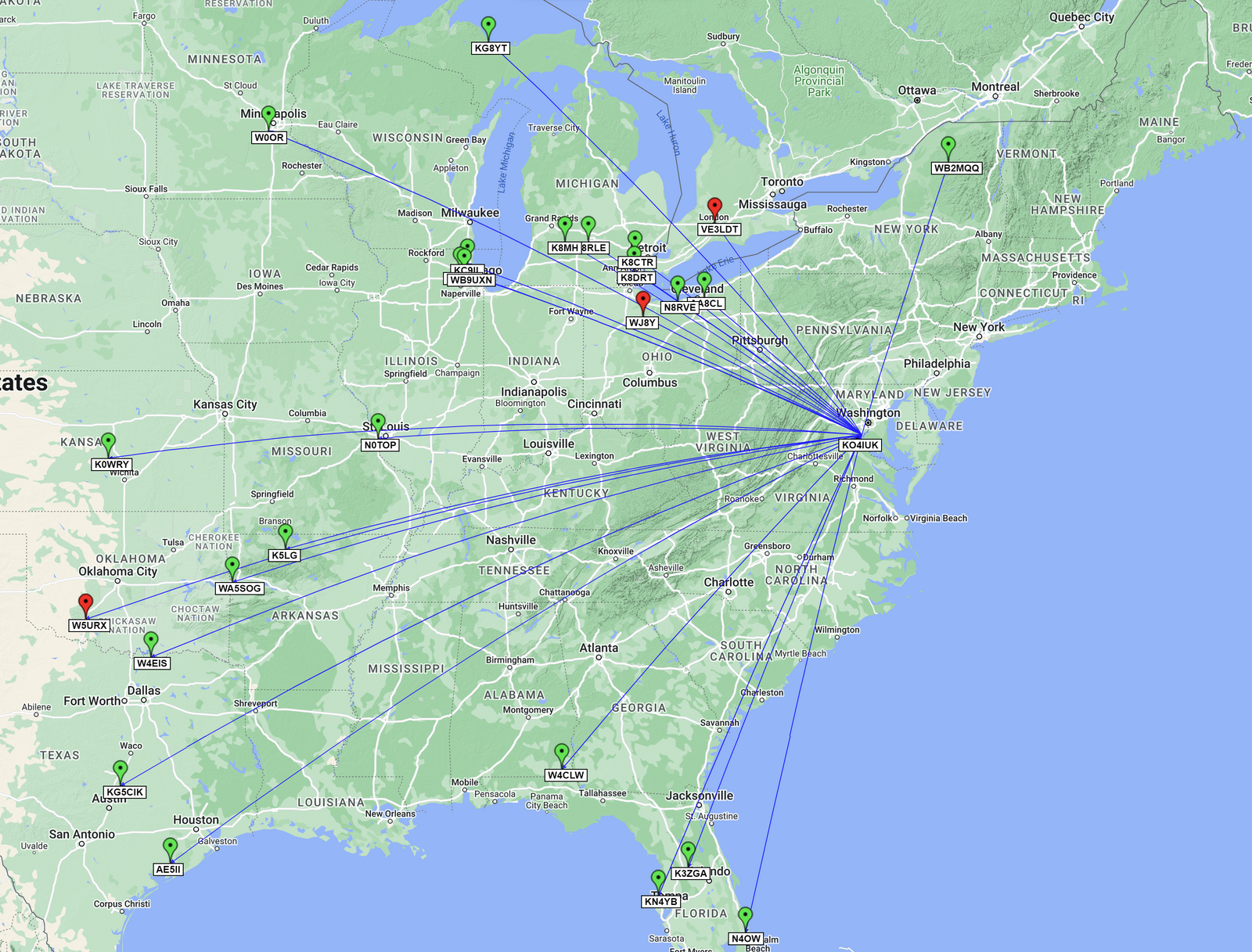
Activation QSO Map: Red Pins = SSB, Green Pins = CW / Blue Lines = 20m, Yellow Lines = 2m/70cm
Gear used in this activation
- Icom IC-705
- Buddipole Buddistick Pro Antenna
- LDG Z100 Plus
- RigExpert Stick Pro Antenna Analyzer
- CW Morse Pocket Double Paddle Morse Code Key with Magnets
- CW Morse Steel Base for Pocket Paddles
- Icom LC-192
- Bioenno 12V 6Ah LiFePO4 Battery
- Sony Headphones
- Dell XPS 13 Laptop
- Rite in the Rain Notebook
- Zebra DelGuard Mechanical Pencil
- Jackery Explorer 500
- Hcalory 50L Portable Fridge/Freezer
Posted on July 18th, 2022
POTA Activation #20 - Occoquan Bay National Wildlife Refuge (VA) (7/10/2022)
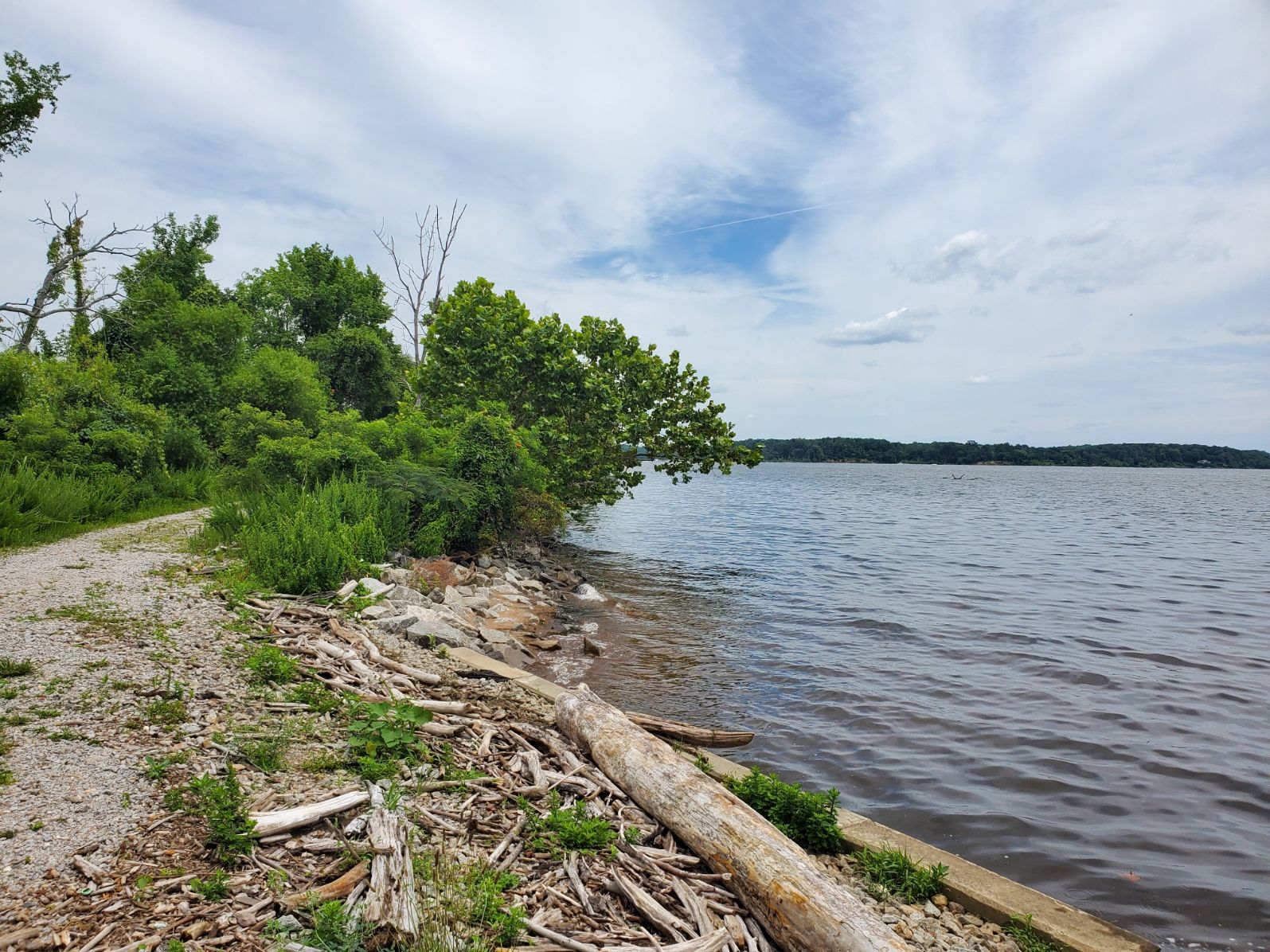
The day after I returned from my vacation in South Carolina we were having a particularly pleasant day in Northern Virginia (especially when compared to the humid swelter of South Carolina). I saw myself nearing 20 distinct parks activated on the POTA web site and was in the mood to spend some quality time outside. The family was enjoying a rest day after the travel of the previous day, so I decided to explore a new-to-me park less than a half hour from where I live.
The Occoquan Bay National Wildlife Refuge sits across Belmont Bay from the first park I ever activated, Mason Neck State Park. The NWR is tucked on the Northeast corner of Woodbridge, Virginia and is a densely vegetated 642 acre refuge for wildlife near the confluence of the Potomac and Occoquan rivers. There are 4 miles of trails through wetland areas and along the banks of the Occoquan. Within 100 feet of the river the activation would be a two-fer with the Captain James Smith Chesapeake National Historic Trail, so I decided to hike on the trail before the activation to scout for a potential operating position near the water. Unfortunately, there weren't many good places to operate since the vegetation was fairly dense along the trail and I didn't want to be blocking part of the trail to activate.
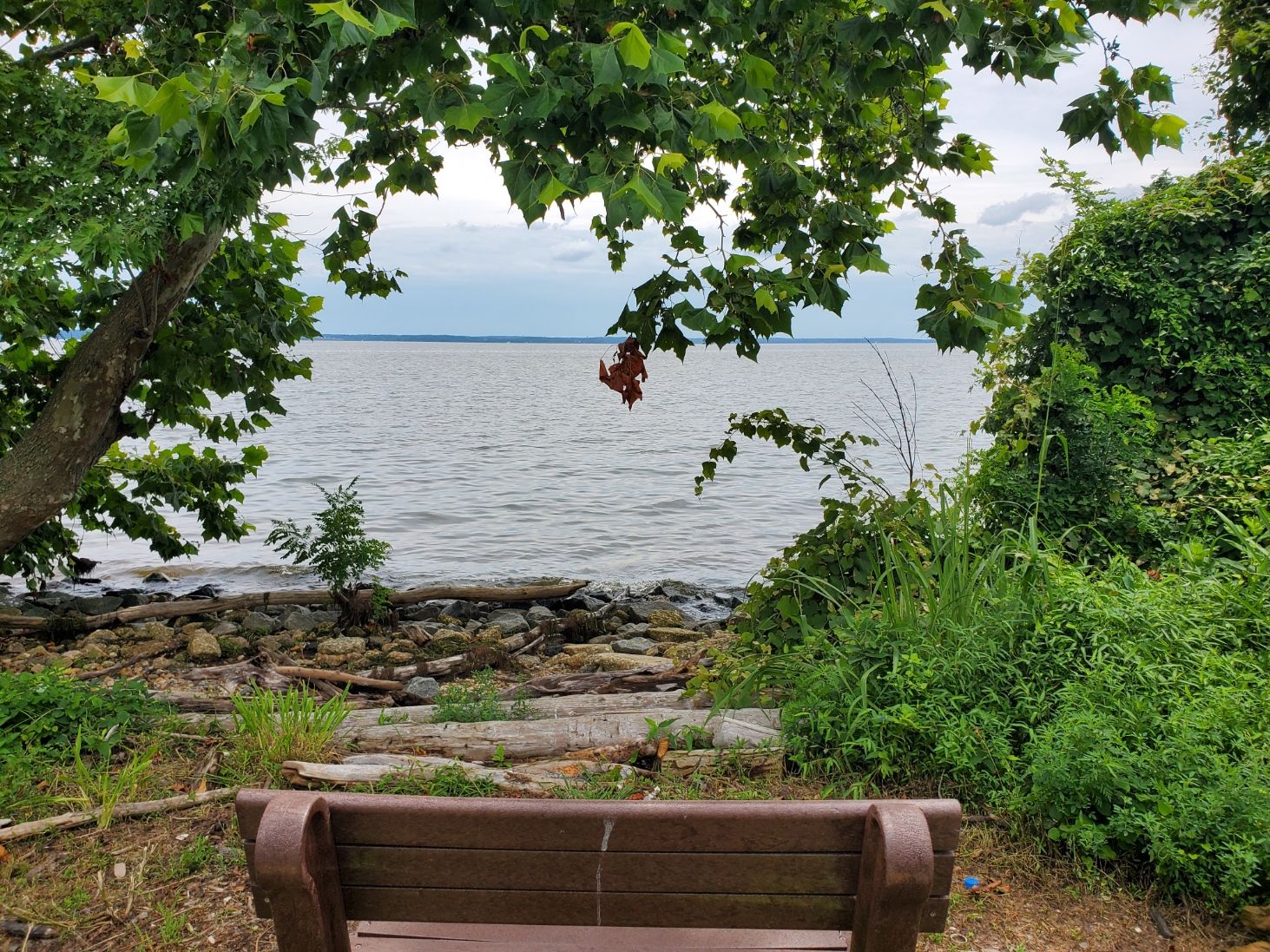
I did find one potential location at a point jutting out into the river, but I would have had to bring in my table and equipment nearly a mile and it was getting hotter, so I decided to loop back to my starting point and set-up near a pavilion (but not in it, as it was already being enjoyed by other visitors). One park was just fine for me.
I assembled my table in front of a bench behind a tree so that I would not be in anyone's way and used my arborist throw line to get my end fed half wave up and over the top of the tree. I was actually able to tie off the end of the line to my antenna to my car, which was quite convenient. Using that trick the line was out of the way of other visitors and I was able to get a nice slope on the antenna.
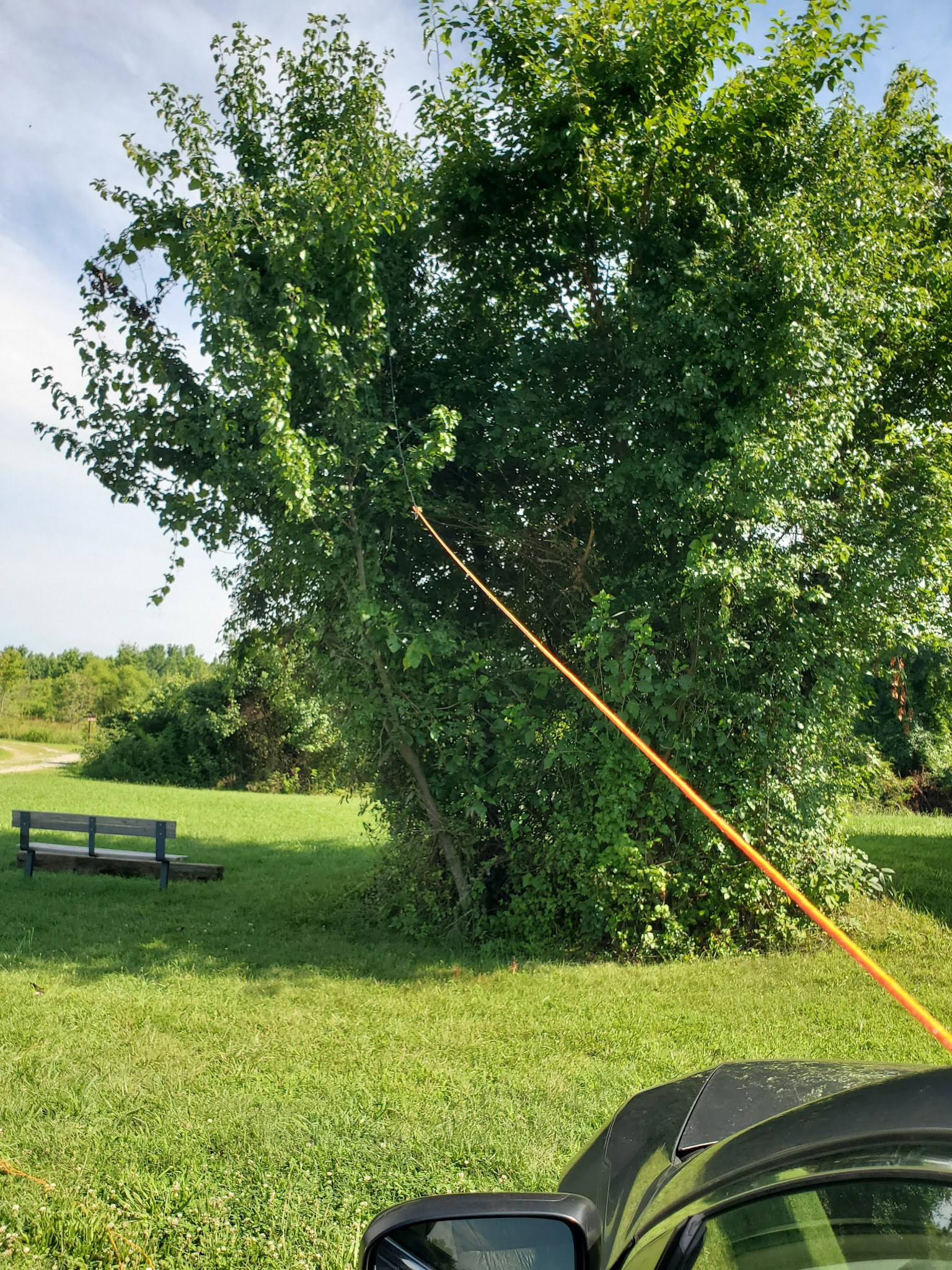
I decided to start the fun on 20m CW. I have been finding in my last few activations that the RBN spotting for POTA has been a bit (pardon the pun) spotty. So after it became clear it wasn't picking me up I spotted manually and I was off. My first contact was with Wisconsin, then Texas, New York, Alabama, Tennessee, Colorado, Florida, and Kentucky. Then I gave 20m SSB a go and made a contact with Kentucky and then the contacts dried up. So I switched over to 40m SSB and made a contact with Connecticut and then had a bit of silence again. I moved down to the CW portion of the band and made contact with Maine, Ohio, North Carolina, New Jersey, and Ohio.
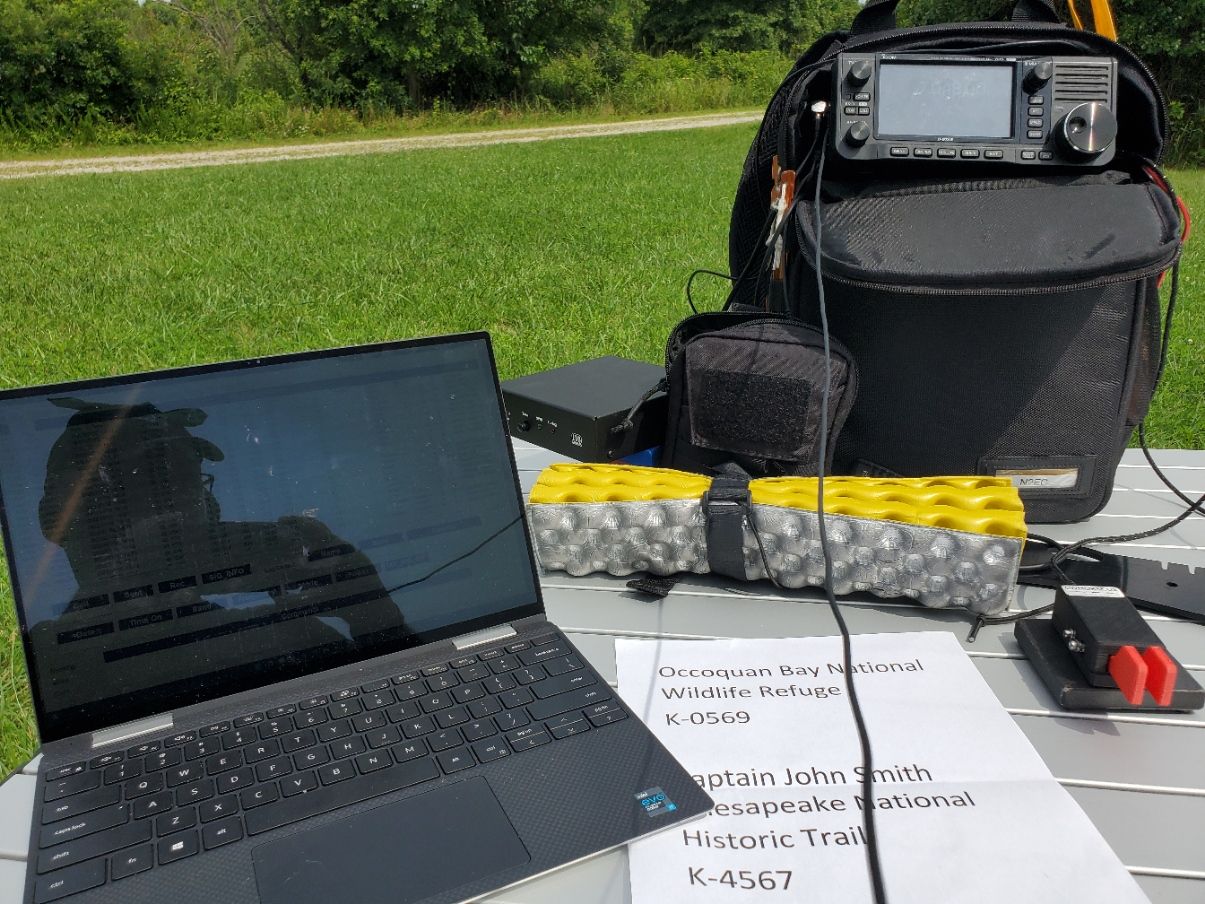
After another lull in contacts, I made a move to the 30m band and had contacts with Illinois, North Carolina, Ontario (Canada), and Missouri. Hopping to yet another band I gave 17m a try, but got no replies, so I went to 15m and made a contact with a station in Arkansas. I gave 12m and 10m a go, but didn't get any takers, so I went back to 20m to hunt some Park to Park contacts and call CQ as well. Calling CQ I made contact with Oklahoma and Wisconsin. With Park to Park contacts I contacted parks in Nova Scotia (Canada) and a pair of activators in Wisconsin. Next I went for a CW Park to Park contact with a station in Ohio.
Next I decided to give calling CQ on SSB another go on 20 and my first contact was a Park to Park in Delaware (although as of this writing, he hasn't posted his logs yet). That contact was followed with contacts in Ohio, New Jersey, Virginia, and North Carolina.
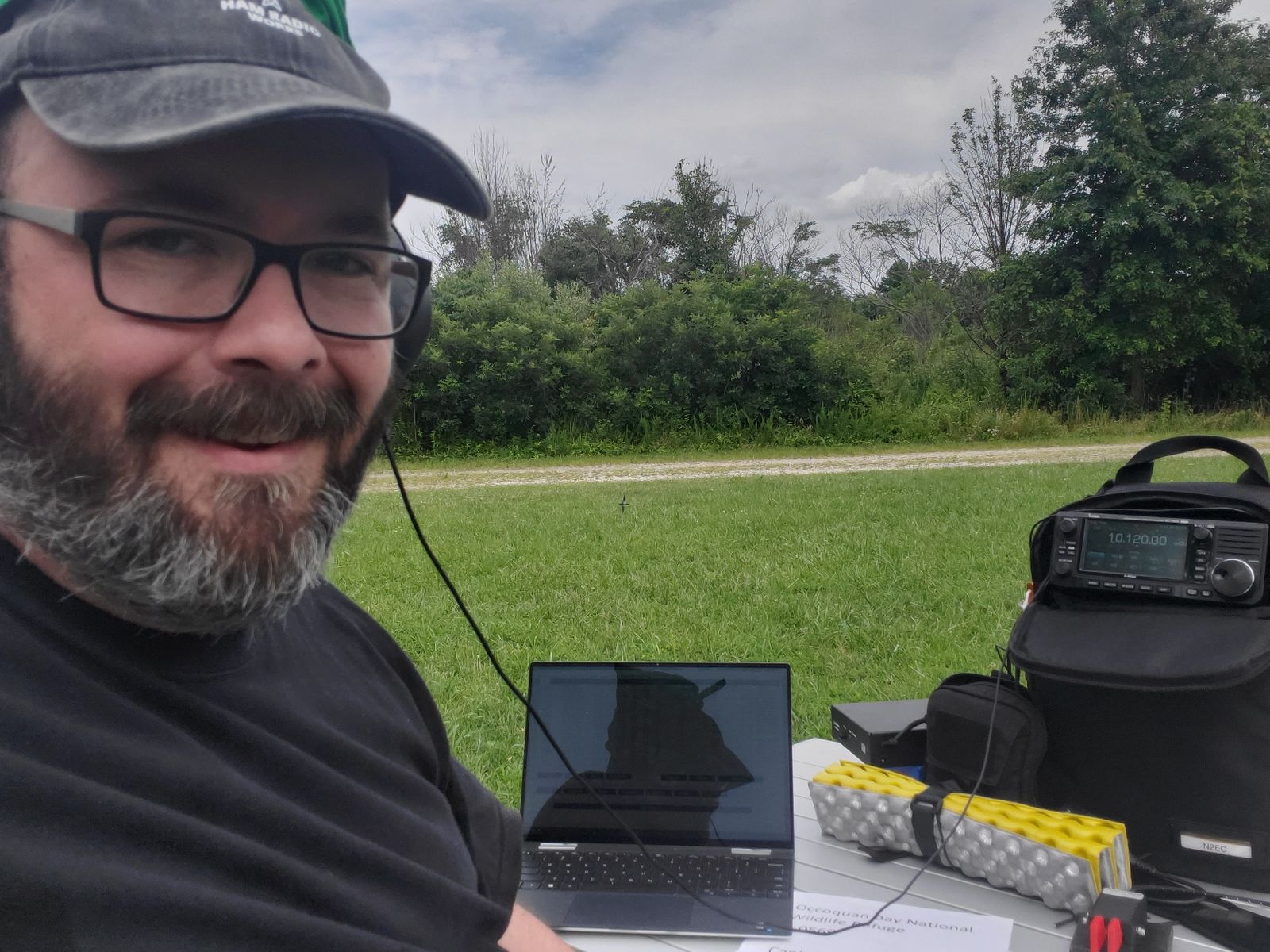
With my cache of cold drinks nearly depleted and 36 contacts in the log (24 CW and 12 SSB) I decided to call it an activation and head back home. I am glad that I decided to visit the Occoquan Bay National Wildlife Refuge, it is a hidden gem right in my back yard. Once you're inside the refuge, it is easy to forget you're adjacent to considerable suburban sprawl and get lost in this green oasis for wildlife. The activation was a lot of fun, and I enjoyed being able to linger for a while and explore different bands.

The picture above shows the pavilion by the parking lot that could be used for future activations. My operating position was behind the tree that is next to it.

Activation QSO Map: Red Pins = SSB, Green Pins = CW / Green Lines = 40m, Orange Lines = 30m, Blue Lines = 20m, Cyan Lines = 15m
Gear used in this activation
- Icom IC-705
- MFJ 1984 MP End-Fed Half Wave Antenna
- LDG Z100 Plus
- CW Morse Pocket Double Paddle Morse Code Key with Magnets
- CW Morse Steel Base for Pocket Paddles
- RigExpert Stick Pro Antenna Analyzer
- Icom LC-192
- Bioenno 12V 6Ah LiFePO4 Battery
- Sony Headphones
- Dell XPS 13 Laptop
- Rite in the Rain Notebook
- Zebra DelGuard Mechanical Pencil
Posted on July 10th, 2022
POTA Activation #19 - Lumber River State Park (NC) (7/9/2022)

I have to be honest -- POTA can be addictive. The operating part is a lot of fun, of course. The deployment of the equipment can be a fun challenge, where you have to make snap decisions about where to operate, which antenna to use, and where to deploy it. The logistics of planning and researching an activation can be a blast, especially when you can find places that exist in multiple parks at once. And actually visiting all these beautiful places is incredibly rewarding in itself. But even apart from the actual activation, the POTA web site turns the whole thing into a game where you're competing against yourself, gaining awards, and deciding what challenges you'd like to pursue. So, while in South Carolina, I was looking at the number of states I had activated parks and saw that I had already activated in 5 of them (Virginia, Maryland, the District of Columbia [not technically a state, but I'm counting it since POTA does], Florida, and South Carolina). I had already been planning on ways to venture out into other states, and it occurred to me ... I was about to drive back home through the state of North Carolina. I had not activated that state yet.
A quick look through the POTA park map and I realized there were some options not too far off my route going home. Closest to the route was a fishing lake just off I-95, but as I researched it, it didn't really appear to be suited for it. It was undergoing some construction and didn't really have any picnic facilities for me and my family to use during the activation. I had my folding table and chair with me, but didn't have enough for the three of us. Looking further I noticed the Lumber River State Park just South of Lumberton, NC. It wasn't too far from where we usually rejoined Interstate 95 and looked to be a pleasant little park that was free to visit and had picnic facilities. After consulting with the family, a plan was hatched. We would leave for the Lumber River State Park, make a quick activation, and then continue on home.
The park itself has two main access areas along the Lumber River which facilitate taking journeys down the river aboard a kayak or canoe. We decided to drive to the Princess Ann access area and were greeted by a sylvan setting that immediately took you past an office by the entrance, past a pavilion, and down to the river itself. There was a boat launch, some seating alongside the river, and a few primitive campsites that were available by the riverside.
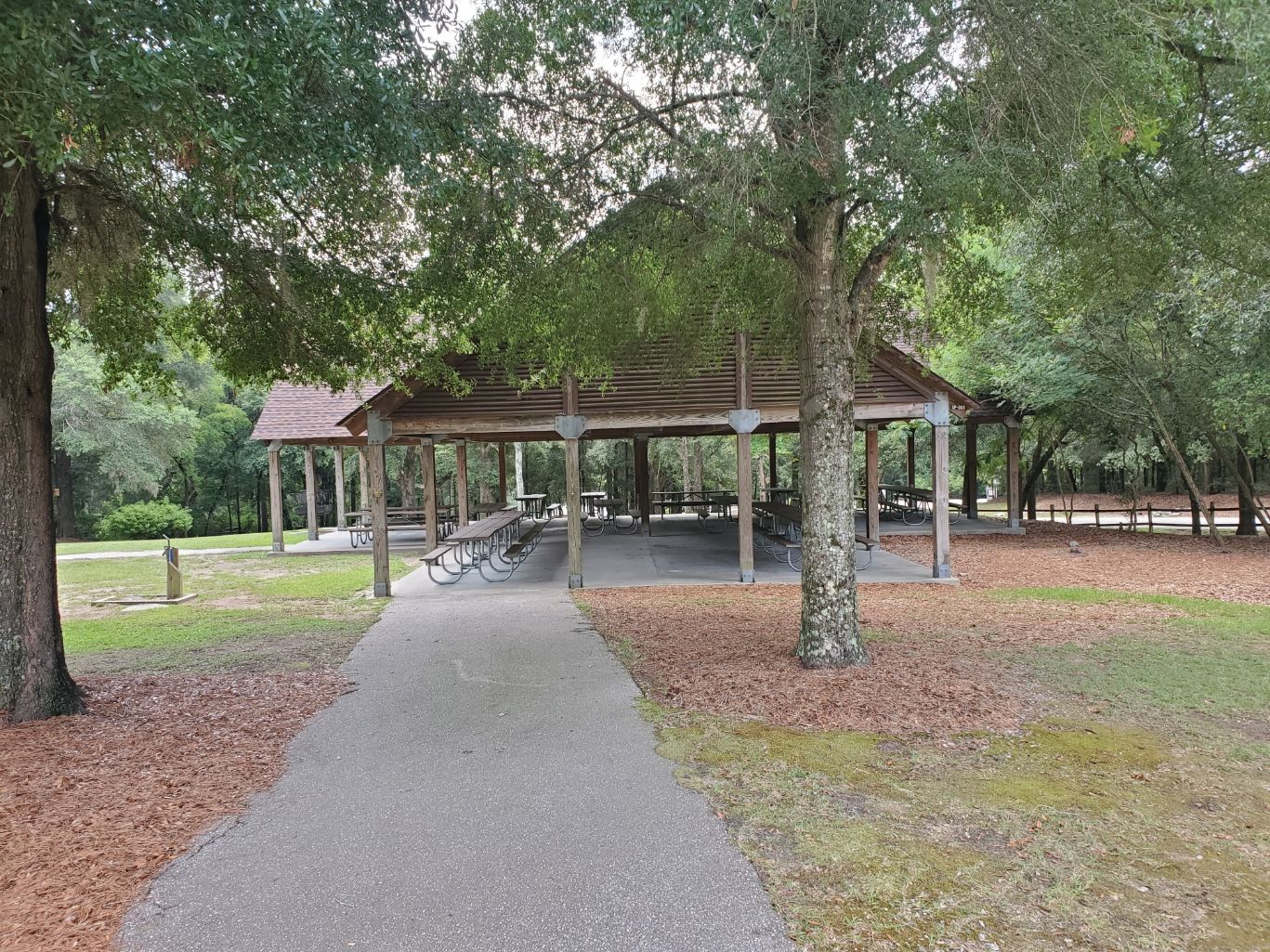
I decided to setup under the large pavilion which was surrounded by trees suitable for the deployment of my end fed half wave antenna. The park was mostly empty, with the exception of a few park employees who were driving around. It was nice to be able to set-up in the shade of the pavilion and I was able to get the antenna in the air and the station on the air in short order. I started on 20m and my daughter assisted in calling CQ. Initially we got two contacts in quick succession with Pennsylvania and Mississippi and then things slowed down quite a bit. In the end we got two more SSB contacts with Indiana and Michigan. It was lunch time, stomachs were grumbling, and we still had many hours of driving ahead of us, so I broke out my trusty morse code paddle and moved down to the CW portion of the band and started calling CQ.
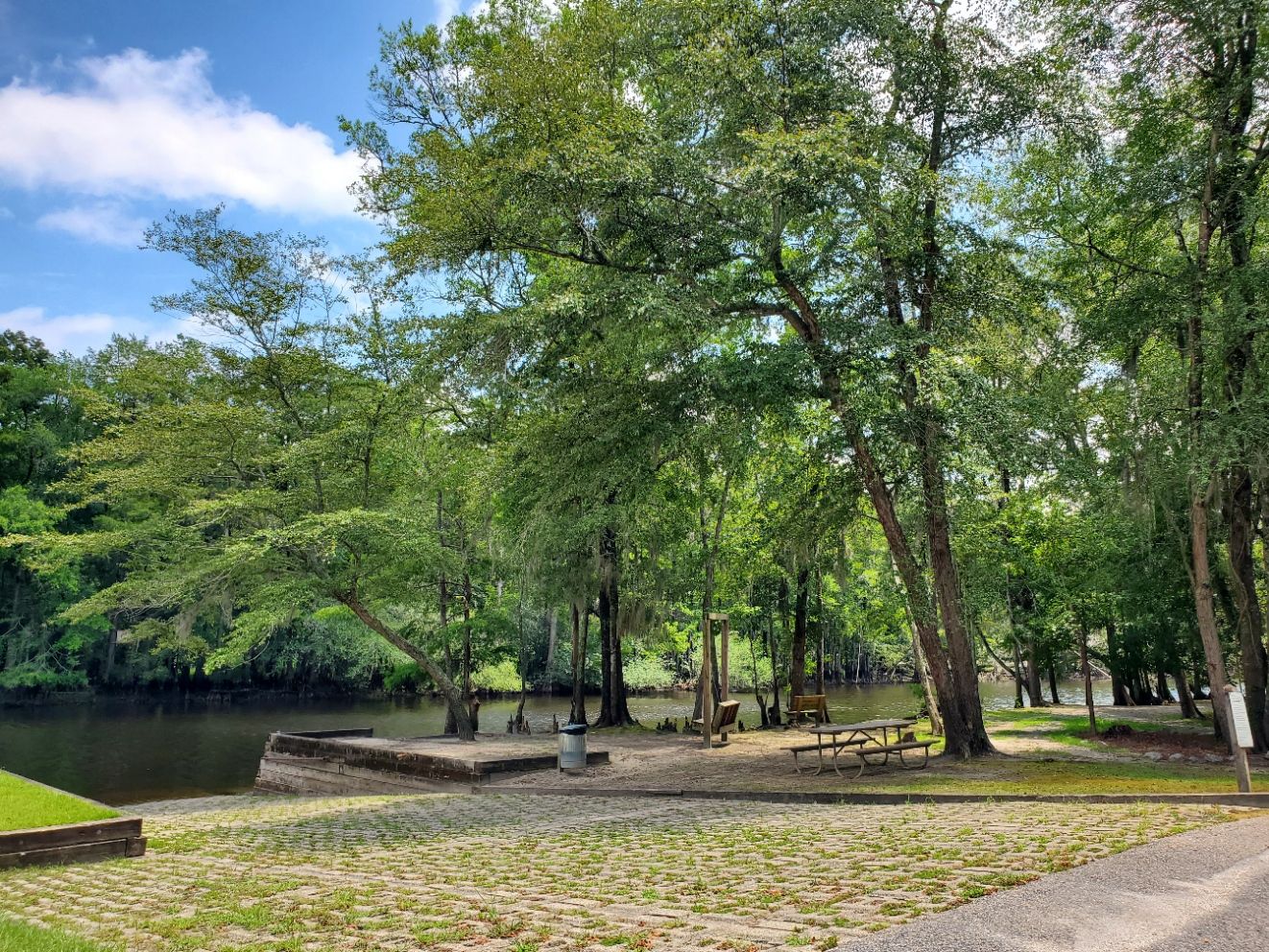
Once I got my spot into the network I started getting replies from New York, Florida, Kentucky, New Jersey, Idaho, Illinois, West Virginia, a trio of Texans, and finally a station in Nebraska. I was impressed that my signal got as far as Idaho. It definitely was the distance winner on this day, reaching nearly across the entire country. My activation had been made and then some with 15 contacts (4 SSB, 11 CW) in just 39 minutes. Since we had a long way to go, I quickly packed up the station and took a stop by the banks of the Lumber River to see some of the beauty the park had to offer.
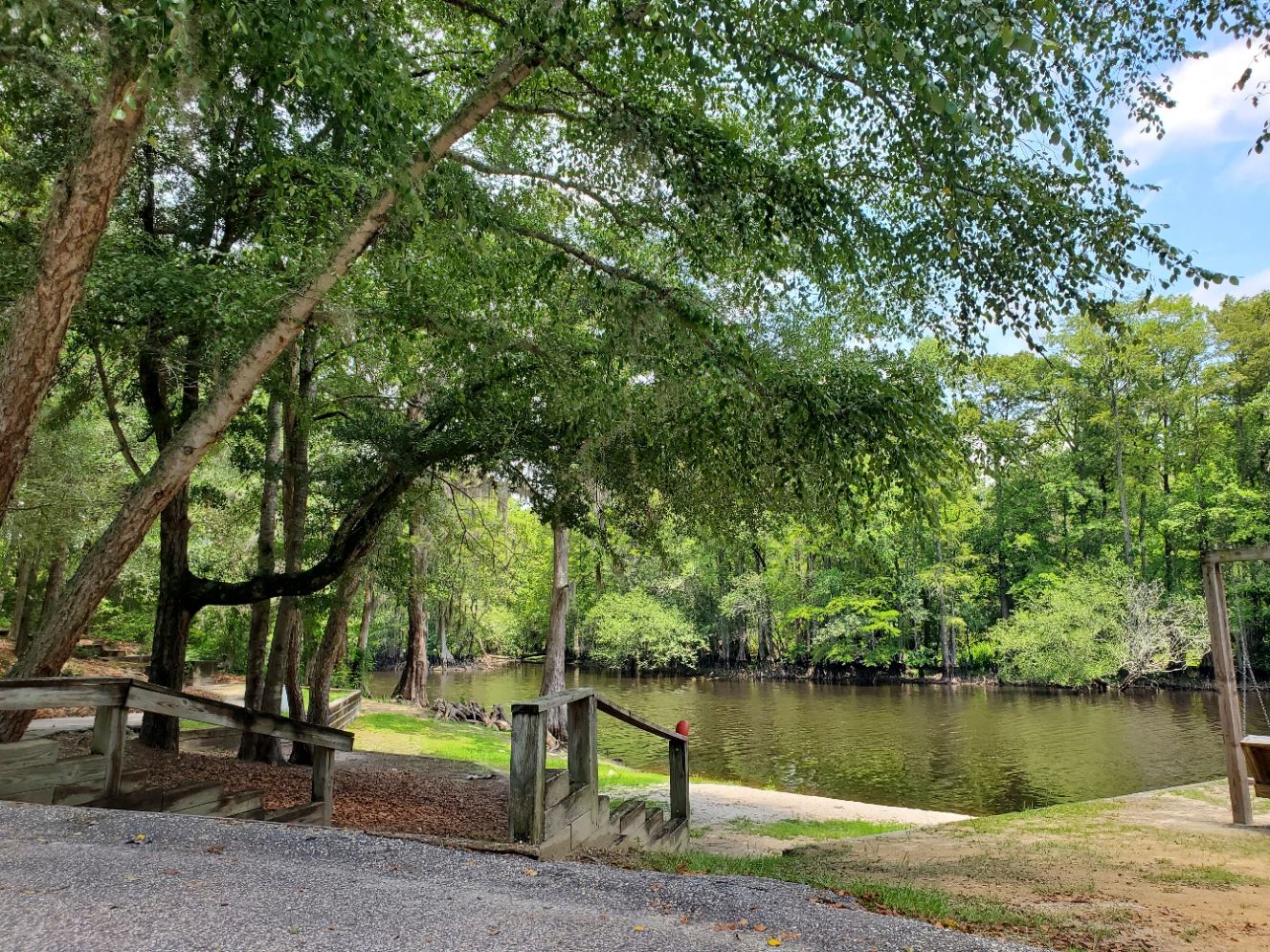
It would have been a nice spot for a hike if we had more time. Even on our abbreviated schedule it was nice to take in the views from the banks of the Lumber River. With a quick activation another state was in the books, bringing my grand total to 6. If all goes well, another one should be added later this month. We were able to grab a quick lunch in Lumberton and then made our way back home, arriving home before dark. It was nice to be able to break up the long drive with an activation to stretch my legs and have some fun amidst the monotony of the road. It was definitely worth the stop.
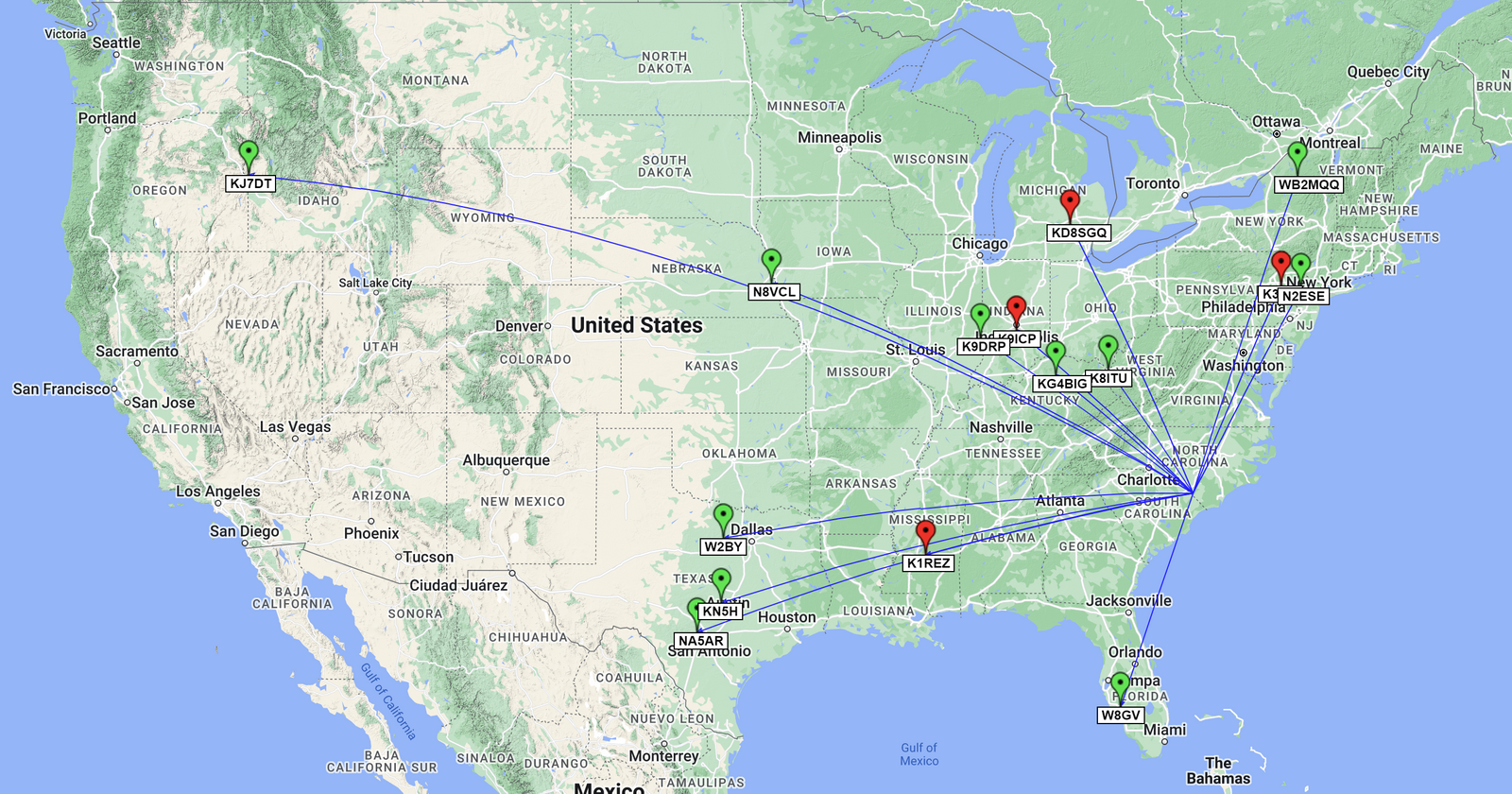
Activation QSO Map: Red Pins = SSB, Green Pins = CW / Blue Lines = 20m
Gear used in this activation
- Icom IC-705
- MFJ 1984 MP End-Fed Half Wave Antenna
- LDG Z100 Plus
- CW Morse Pocket Double Paddle Morse Code Key with Magnets
- CW Morse Steel Base for Pocket Paddles
- RigExpert Stick Pro Antenna Analyzer
- Icom LC-192
- Bioenno 12V 6Ah LiFePO4 Battery
- Sony Headphones
- Dell XPS 13 Laptop
- Rite in the Rain Notebook
- Zebra DelGuard Mechanical Pencil
Posted on July 10th, 2022
POTA Activation #18 - Myrtle Beach State Park (SC) (7/6/2022)
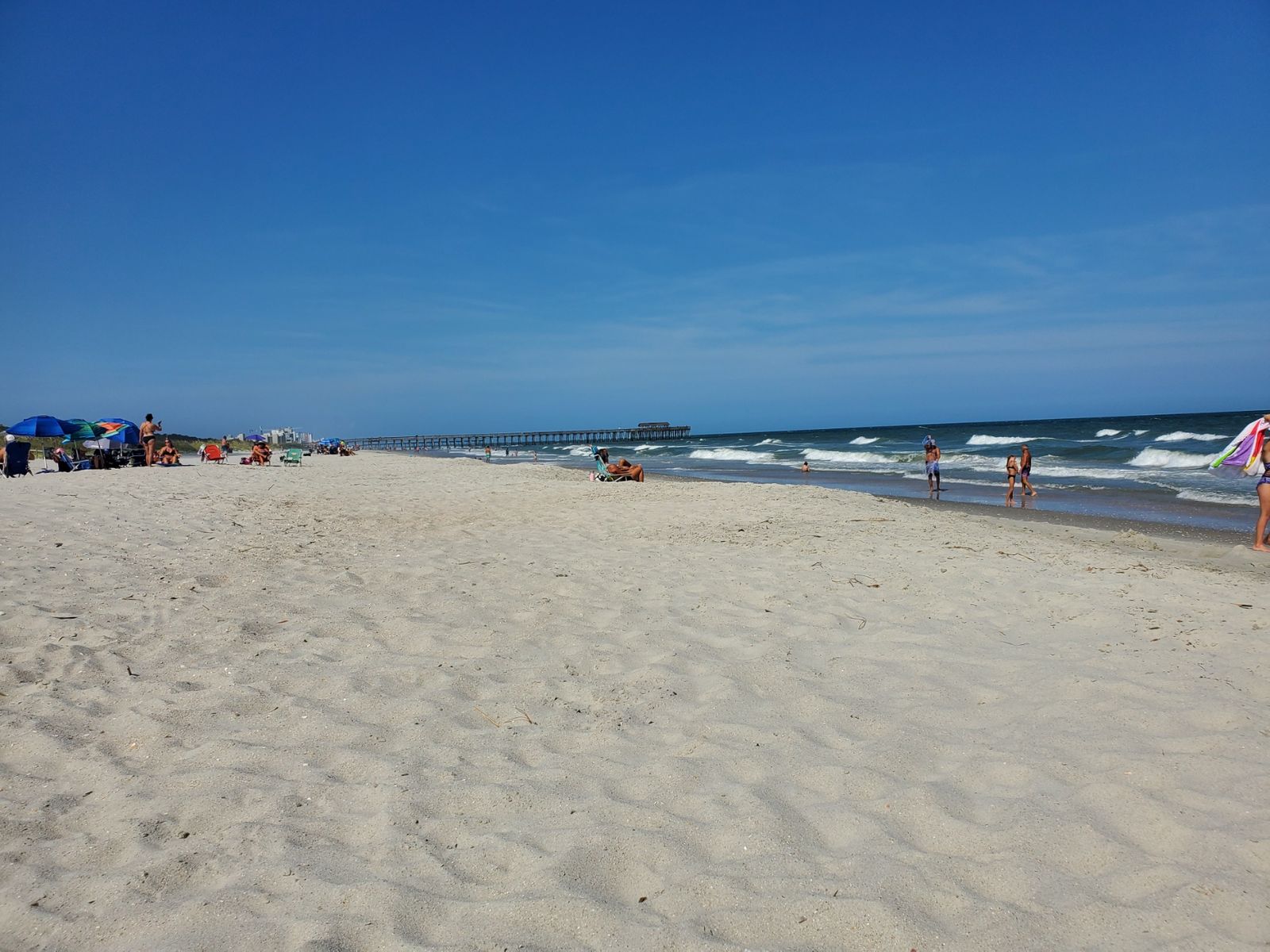
Just one day after my successful activation of Huntington Beach State Park we took a trip just up the road to Myrtle Beach State Park for some time at the beach and fun on the air. As soon as you pull off of US-17 Business at the park entrance you're taken through a dense forested drive that winds around until you emerge in a parking lot just behind the dunes that protect the beach. It was a bit busier than it was over at Huntington Beach State Park, so we went South along the drive that parallels the beach until we found a parking spot near the beach access. Conveniently, a sizable covered pavilion was near where we had parked our car, so we had a great spot to eat the picnic lunch we had brought with us. It was also a great spot to be able to activate the park in the shade. A short walk from the pavilion was a bathroom facility with changing rooms.
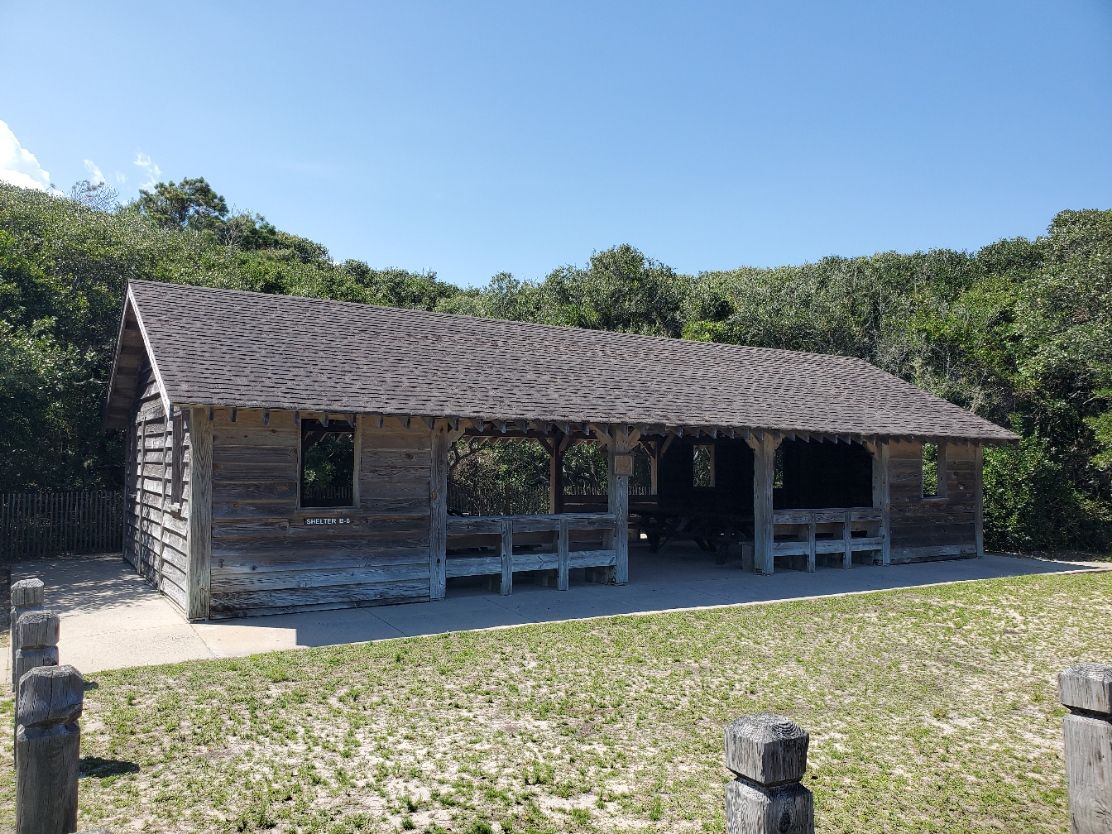
The area around the pavilion was fenced off, so getting a line up into the trees was not going to be an easy proposition. Thankfully, I brought my Buddistick Pro with me, so I was able to set it up just outside the pavilion with the vertical and radials out of the way of passers-by. I was able to get everything up and running pretty quickly on 20m and my daughter helped me call CQ for a few contacts.

The first contact on SSB was from Florida, followed by Indiana, Arkansas, and Kentucky. After some initial success things slowed on SSB, so my family headed to the beach for some time in the sun and sand and I shifted down to the CW portion of the band to see what I could do with my paddle.
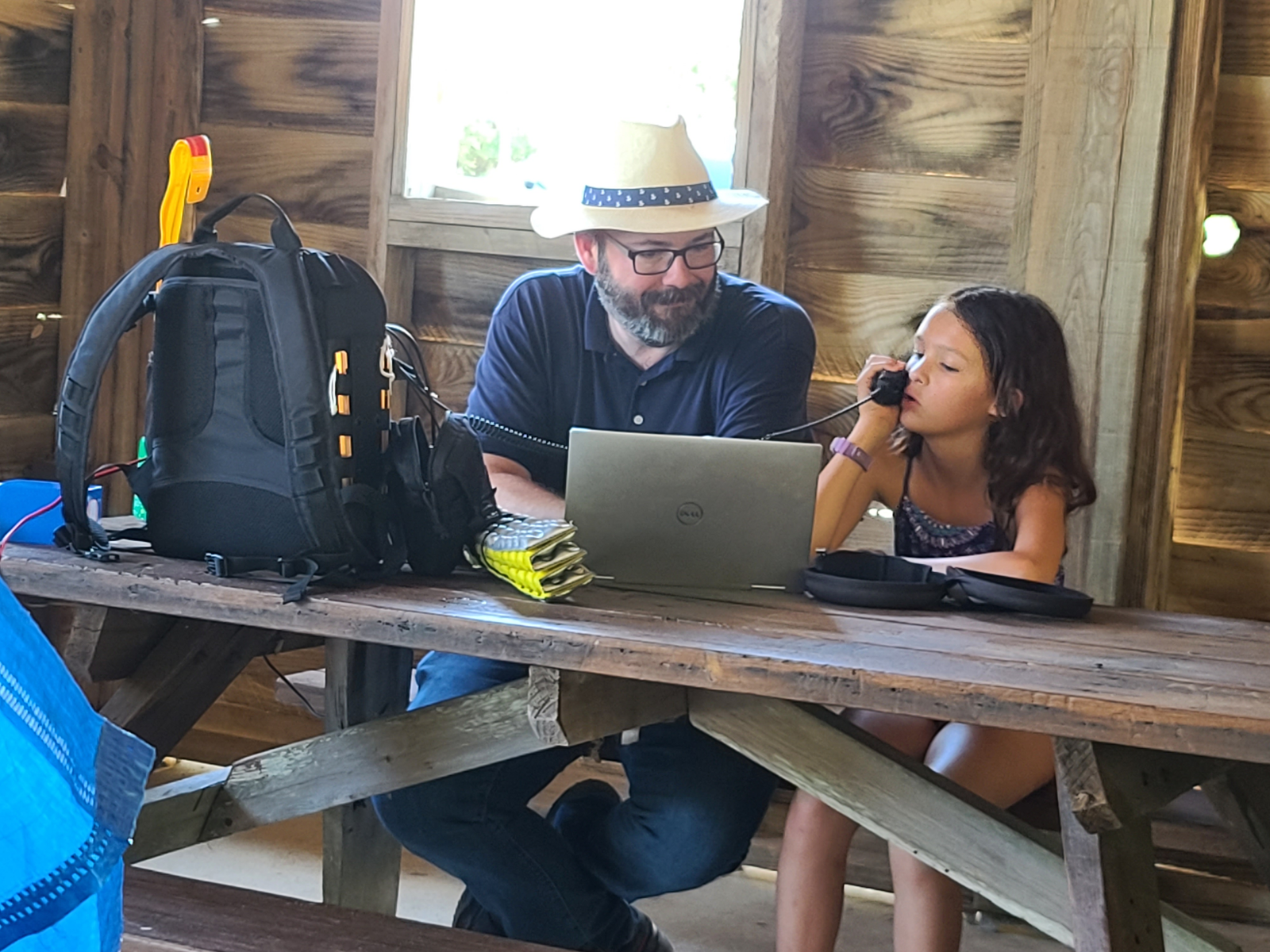
Conditions may not have been fantastic this day, but I made up for it with persistence. I made contacts via CW with North Carolina, Pennsylvania, Connecticut, Tennessee, Florida, Michigan, Wisconsin, Texas (a Park to Park contact), Iowa, two more Texas contacts, Illinois, West Virginia, and a Park to Park with Colorado. Finally, I looked at the spots and decided to hunt for whatever Park to Park stations I could find and ended up getting one on SSB in Ohio.

With 16 CW contacts, 5 SSB, and 3 Park to Parks for a total of 21, I decided to call it an activation and join the family on the beach. Not the highest QSO count, but still a lot of fun. After breaking down the station and changing into my swim trunks, I went into the water with my daughter. Although the surf was a bit rough, we had a lot of fun cooling off in the cool waters of the Atlantic.

One thing of note: this park, like Huntington Beach to the South can be closed if the parking lots fill up (we experienced that on a weekend day going to Huntington), so if you're going to activate on a weekend, you may want to get in early. That said, with the shelter and facilities, this is a fun place for an activation and a swim.

Activation QSO Map: Red Pins = SSB, Green Pins = CW / Blue Lines = 20m
Gear used in this activation
- Icom IC-705
- Buddipole Buddistick Pro Antenna
- LDG Z100 Plus
- RigExpert Stick Pro Antenna Analyzer
- CW Morse Pocket Double Paddle Morse Code Key with Magnets
- CW Morse Steel Base for Pocket Paddles
- Icom LC-192
- Bioenno 12V 6Ah LiFePO4 Battery
- Sony Headphones
- Dell XPS 13 Laptop
- Rite in the Rain Notebook
- Zebra DelGuard Mechanical Pencil
Posted on July 10th, 2022
POTA Activation #17 - Huntington Beach State Park (SC) (7/5/2022)

The first week of July I went down to Myrtle Beach, South Carolina with the family to visit my mother. I brought my portable radio setup and planned on getting a few activations in while on the trip. The first park we decided to visit was Huntington Beach State Park, just South of Myrtle Beach near Murrell's Inlet. The park was derived from 2,500 acres of property owned by Anna Hyatt Huntington and Archer Huntington. The park also has their castle, Atalaya.

Anna Hyatt Huntington was a sculptor of renown who was afflicted by tuberculosis. Atalaya was built as a warm weather retreat for her by the sea during the depression in the hopes of ameliorating her condition. The castle is large and sprawls around a central courtyard. The North side of the castle has the support structures housing the staff and the kitchen, while the South side has the rooms that were occupied by the Huntington family. They intentionally built it without guest rooms, as they did not want to entertain guests while at Atalaya. The ocean is a short walk away from the castle and the waves can be heard gently rolling in from inside the house which is currently open to the outside air without windows. The park itself is across US-17 from Brookgreen Gardens which was also owned by the Huntington family and is definitely worth a visit (we went later in the week).
One thing of note: on weekends this park can fill its parking lot to capacity and be closed to additional visitors. This happened to us over the weekend, so we had to come back during the week. If you're looking to activate over the weekend, you may want to get there early.

In addition to Atalaya Castle, the park has a beautiful beach on the Atlantic with white sand that was mostly empty the day we visited.

After touring Atalaya I found a nice shady spot under some trees beside the castle and set up my station. Since I had trees available, I decided to use my MFJ 1984 MP End-Fed Half Wave antenna and used my arborist throwline kit to get it up in a tree. I started the activation on 20m SSB and after a slow start made contact with Texas, Maine, Florida, Arkansas, Georgia, Indiana, New York, and Minnesota. Things slowed down and I decided to drop down to the CW portion of the band and made contact with Maryland, Puerto Rico, Ohio, New Jersey, Tennessee, Alabama, Kansas, Texas, Arizona, and Ontario, Canada. After another slow down I decided to take advantage of the frequency agility of the antenna and move over to 30m making contacts with Maryland, Alabama, and Ohio. After another dry spell I moved over to 17m and made contacts with Alabama and Florida. After another period of calling CQ into the void, I went over to 40m and made contact with Ohio, Pennsylvania, Florida, and Virginia.

After she had done some exploring around the park, I was rejoined by my daughter who wanted to join me on the mic and call CQ for a bit. Together we worked 40m SSB and made contact with North Carolina, Maryland, Kentucky, West Virginia, the District of Columbia, and Virginia.

She did a great job on the mic and the hunters were extra friendly when they heard her voice. She had a lot of fun and so did I. One of the things I love about Parks on the Air is the kind and collegial manner in which activators and hunters interact. Hearing a young girl on the air, everyone was so kind and did everything they could to make it a great experience. The POTA hunters are a great group of operators. All told we made 43 contacts with 27 on CW and 16 on SSB including 2 Park to Park QSOs. A very successful activation on 10W.

After breaking down the station we walked on the beach for a bit and Caitlin enjoyed running through the waves on the beautiful white sand beach.

Activation QSO Map: Red Pins = SSB, Green Pins = CW / Green Lines = 40m, Orange Lines = 30m, Blue Lines = 20m, Purple Lines = 17m, Cyan Lines = 15m
Gear used in this activation
- Icom IC-705
- MFJ 1984 MP End-Fed Half Wave Antenna
- LDG Z100 Plus
- CW Morse Pocket Double Paddle Morse Code Key with Magnets
- CW Morse Steel Base for Pocket Paddles
- RigExpert Stick Pro Antenna Analyzer
- Icom LC-192
- Bioenno 12V 6Ah LiFePO4 Battery
- Sony Headphones
- Dell XPS 13 Laptop
- Rite in the Rain Notebook
- Zebra DelGuard Mechanical Pencil
Posted on July 10th, 2022
POTA Activations #14, #15, and #16 - Shenandoah National Park 3 Day Activation (VA) (6/18/2022-6/20/2022)

After the four-fer earlier in the week, I was energized and eager to get back out in the field and see what I could do. Thankfully, I didn't have to wait long this time. In fact, technically, it was the next Zulu day. My daughter has a sleep-away camp scheduled for later in the Summer in the Shenandoah valley and they were having an open house so that parents and campers could see what is in store. We decided to make the nearly 3 hour trek down to the campground and then backtrack for a three day, two night stay at Skyland Resort inside Shenandoah National Park. The open house was fantastic -- I wish I was able to go to this camp! My daughter was excited too. We ended up spending most of the day there exploring all the different campsites and facilities. We got to shoot a slingshot, see the archery grounds, and enjoy the beautiful surroundings. When we headed back to our car we saw that it was getting close to the end of the Zulu day. We made our way to Shenandoah National Park's Swift Run Gap entrance and headed North on the Skyline drive in search of a place to get in a quick activation.
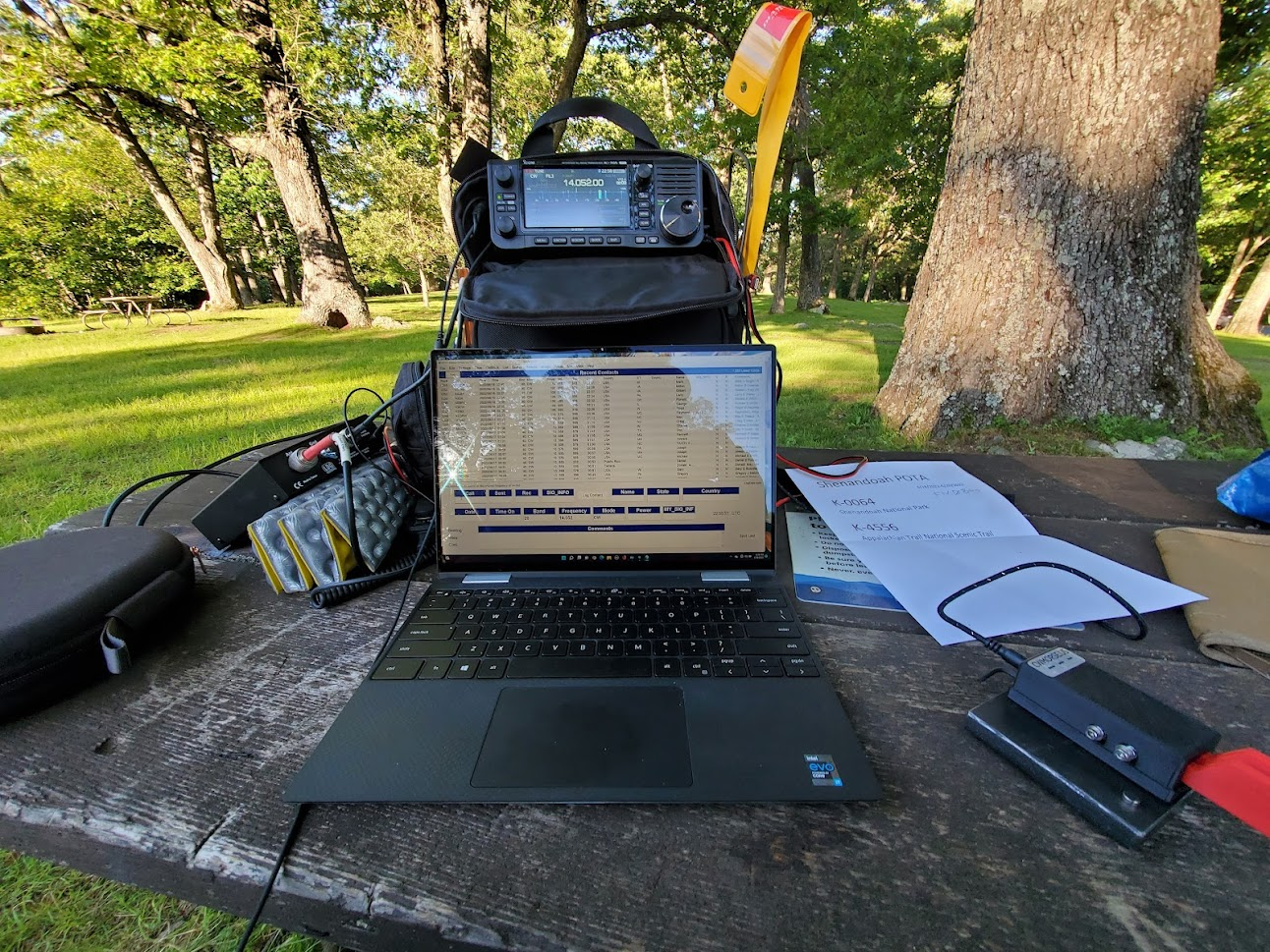
Just up the drive from the entrance station was South River Picnic Grounds. When I got out of the car I noticed it was surprisingly chilly, so I put on a jacket and got started setting up. I got my gear onto a picnic table by a grand old tree and tossed my line up to a high branch to pull up my MFJ 1984 MP End Fed Half Half Wave antenna. I was up and running pretty quickly and decided to start with CW on 20m, but heard nothing but crickets. I then called CQ on 40m and started getting answers. My cell phone was not working, so I was completely reliant on the Reverse Beacon Network to hear me and to report me on the spots. I got replies from Virginia, Pennsylvania, Ohio, Indiana, Illinois, and Michigan. Then nothing for several minutes. I had 7 contacts and I had less than an hour to make 3 more to have a valid activation, so I decided to fall back on FT8 to save the day and in short order I had 5 more contacts from Georgia, Arkansas, Michigan, New York, and Pennsylvania. 12 contacts in 49 minutes -- longer than I had hoped, but it worked. With the first activation validated, I quickly broke down the station and we made our way to dinner at Big Meadows Lodge as everyone in our crew was quite hungry.
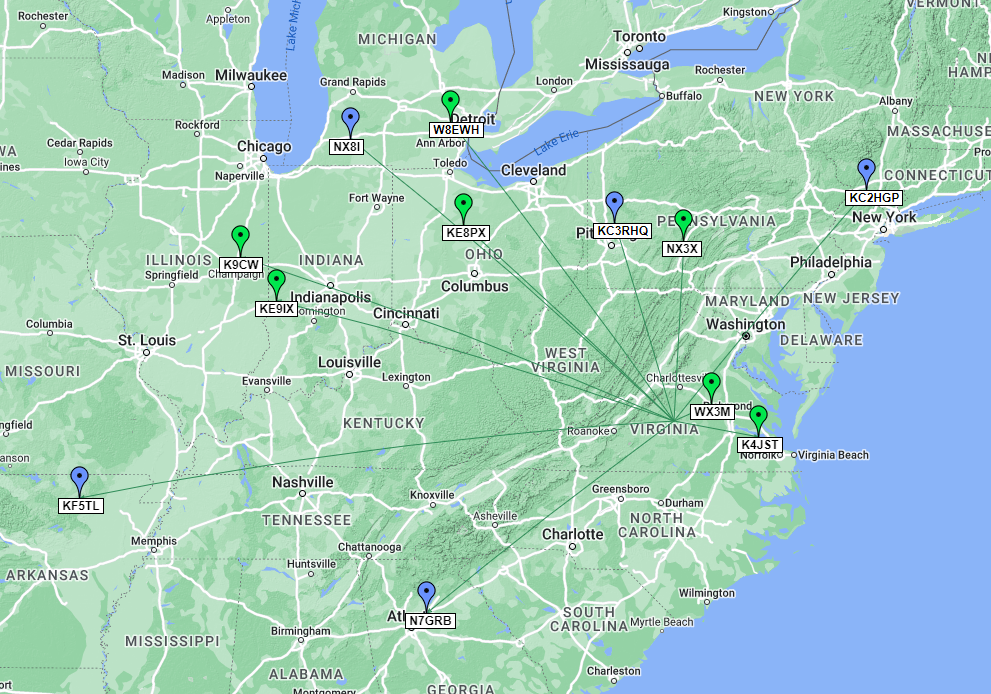
6/18/2022 Activation QSO Map: Green Pins = CW, Blue Pins = Digital / Green Lines = 40m
After dinner we checked-in to our accommodations further up the drive at Skyland Lodge. It was already dark, and we quickly unloaded our car and got situated in our room. Although we could only see the lights in the valley below that night, our room had a commanding view. After everyone else was ready to retire for the evening, I set up my station on the balcony our room had. I didn't want to mess with shooting my wires up into the trees at night, so I decided to use the pole I use for my Buddistick Pro to keep the antenna off the ground, albeit not very far. I doubled up on jackets as the temperatures were going down into the lower 40s and got out my paddle and started calling CQ. At 2:32Z I got my first call and the calls kept coming. Virginia, North Carolina, Georgia, Florida, Mississippi, Arkansas, Indiana, Illinois, Michigan, Pennsylvania, and New Hampshire answered my calls on 40, 30, and 20m. In all I got 20 contacts in 1:09 of operating during the late shift. I had a few times where my sending was not the best due to cold fingers, but I had a lot of fun. With more than double the amount of contacts needed for a complete activation in the books and the midnight hour fast approaching, I decided to call it a night.

6/19/2022 Activation QSO Map A (0:00-4:00Z): Green Pins = CW, Green Lines = 40m, Orange Lines = 30m, Blue Lines = 20m
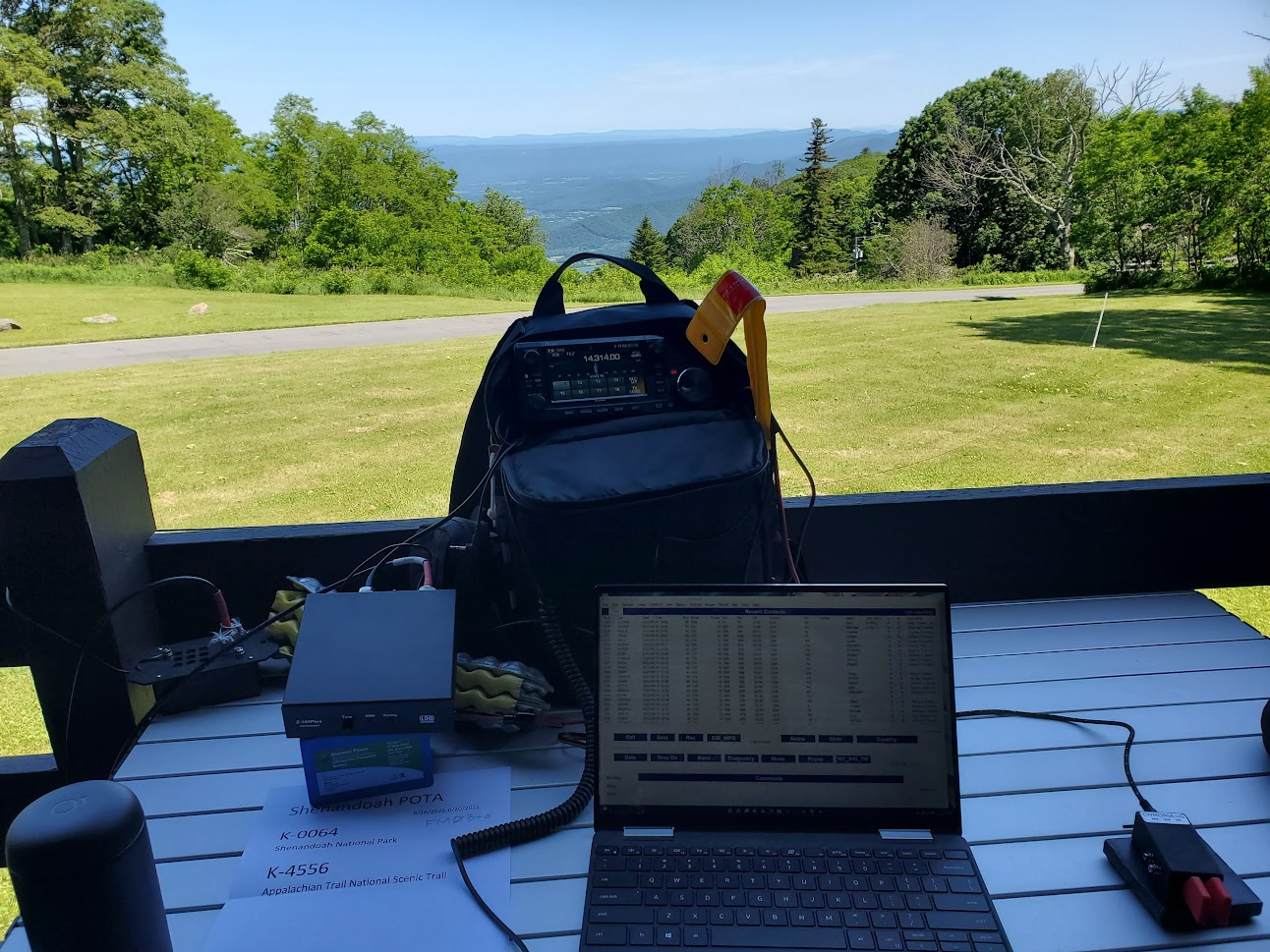
The following morning we got up and had breakfast up at the lodge and enjoyed the beautiful blue skies and a bit of a chill in the air. We got back to the room for a little after breakfast break and I made a handful of contacts doing a little hunting on 40 and 20 CW and SSB along with some calling CQ. After getting 5 more contacts we decided it was time to go for a hike and opted for a quick trip up to Stony Man Summit as a family. The hike from the trailhead was 1.71 miles according to my Strava app with 297 feet of elevation gain. The view from the summit at 4,011 feet was spectacular. We were surprised to find that the puddles in some of the rocks at that elevation had what appeared to be tadpoles in them. Life definitely finds a way, even on the summit of a mountain. We savored the views for a bit before heading back down to the trailhead.
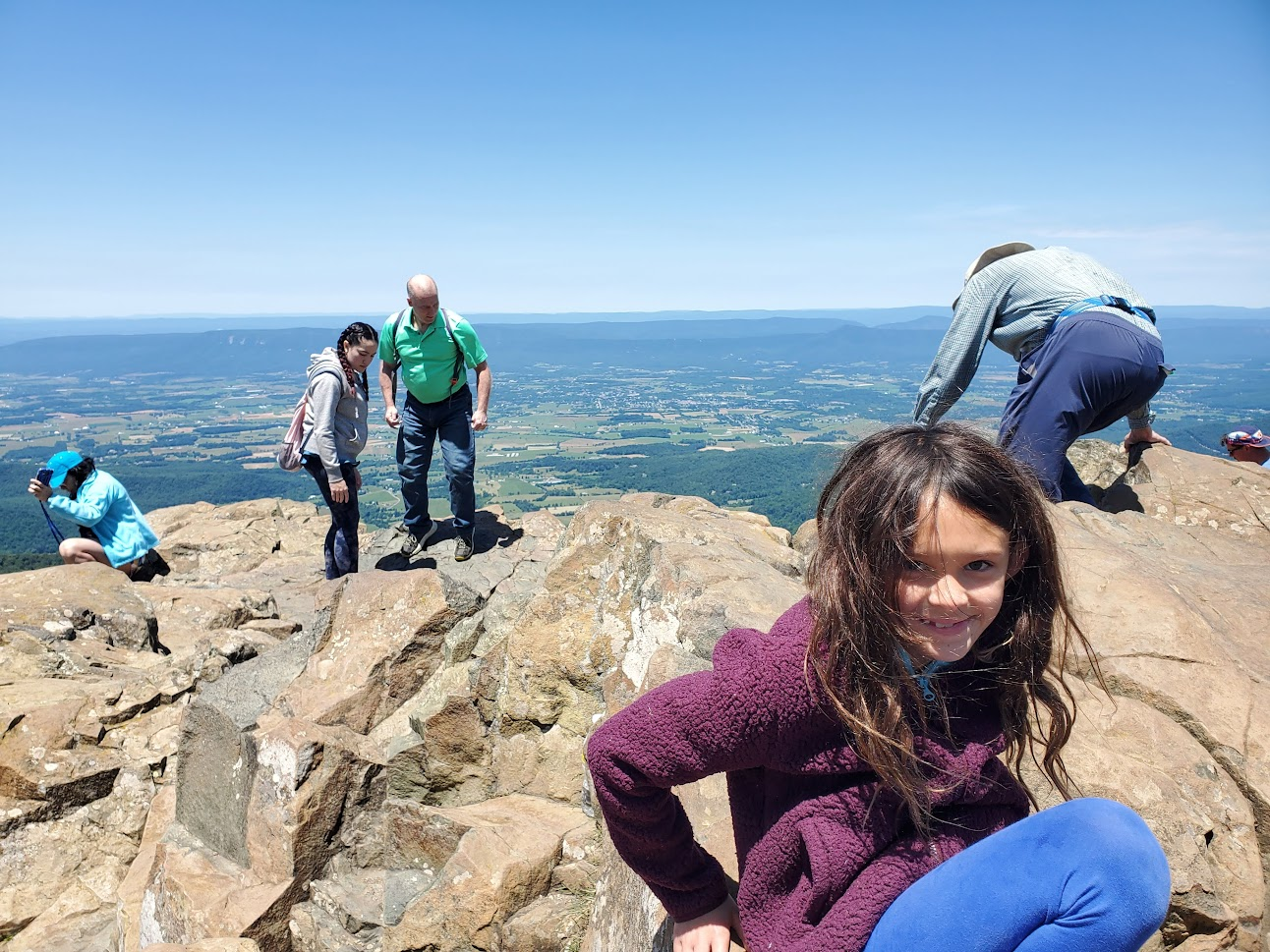
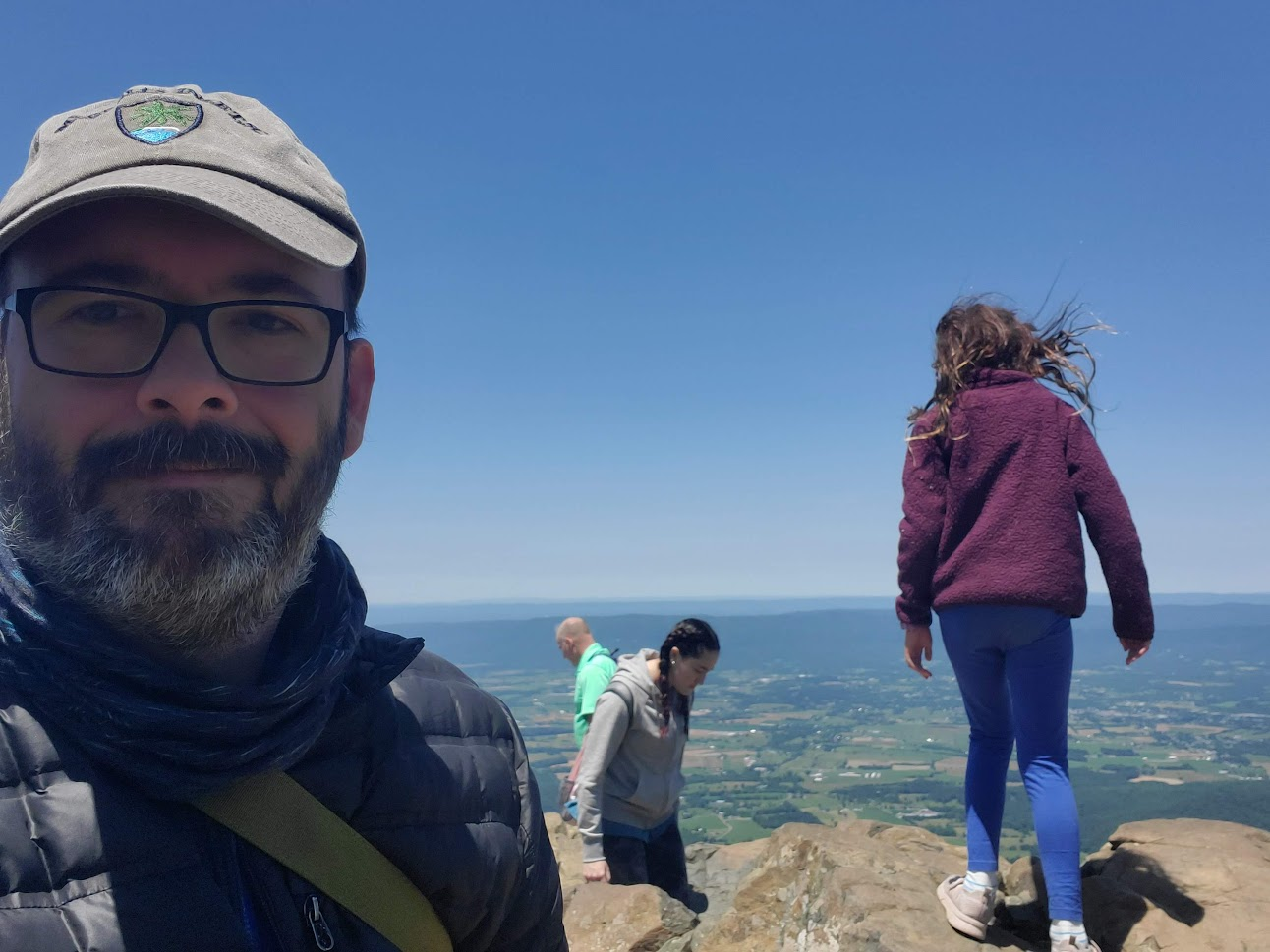
After our hike we made our way back to the hotel and I also got my antenna higher up into a tree using my throw line kit. I decided to give 20m a go on CW and made 8 contacts in quick succession, then I decided to head over to 40m where I got another 11 quick contacts. After a 50 minute operating break I decided it was time to give SSB a try, so I got onto 40m, found a clear frequency, and had an absolute blast. Very quickly I got into a rhythm and was having fun with the ensuing pileup. When the dust cleared I had 38 contacts in 49 minutes on SSB. With 50 minutes left in the Zulu day we decided to get some dinner up at Skyland Lodge. For the non-late shift part of the activation I was able to work stations in Massachusetts, New York, Connecticut, Ontario (Canada), Pennsylvania, Ohio, Michigan, Indiana, Illinois, Kansas, Oklahoma, Texas, Louisiana, Alabama, Georgia, North Carolina, South Carolina, Delaware, New Jersey, and Virginia.
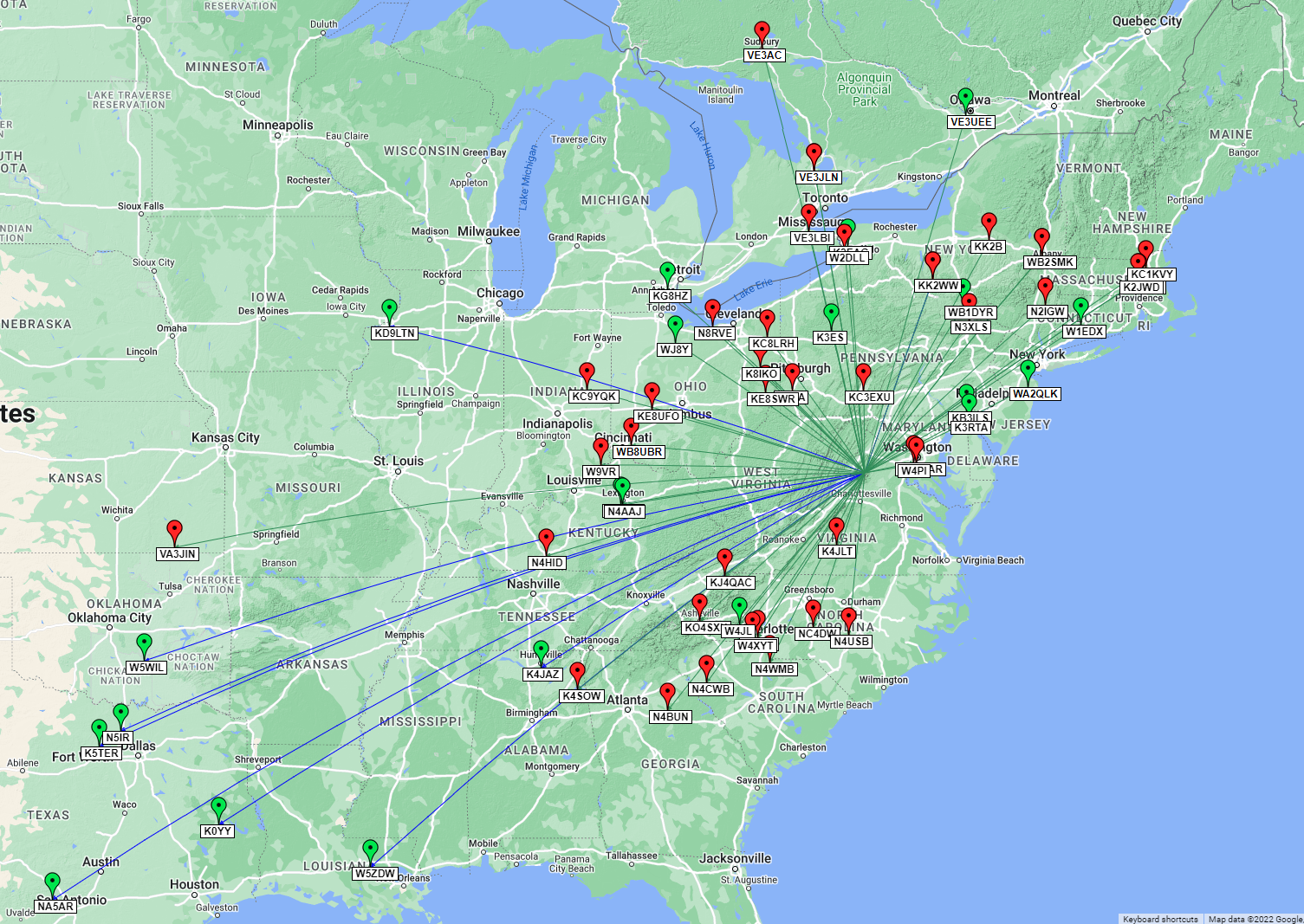
6/19/2022 Activation QSO Map B (4:00-23:59Z): Green Pins = CW, Red Pins = SSB, Green Lines = 40m, Blue Lines = 20m

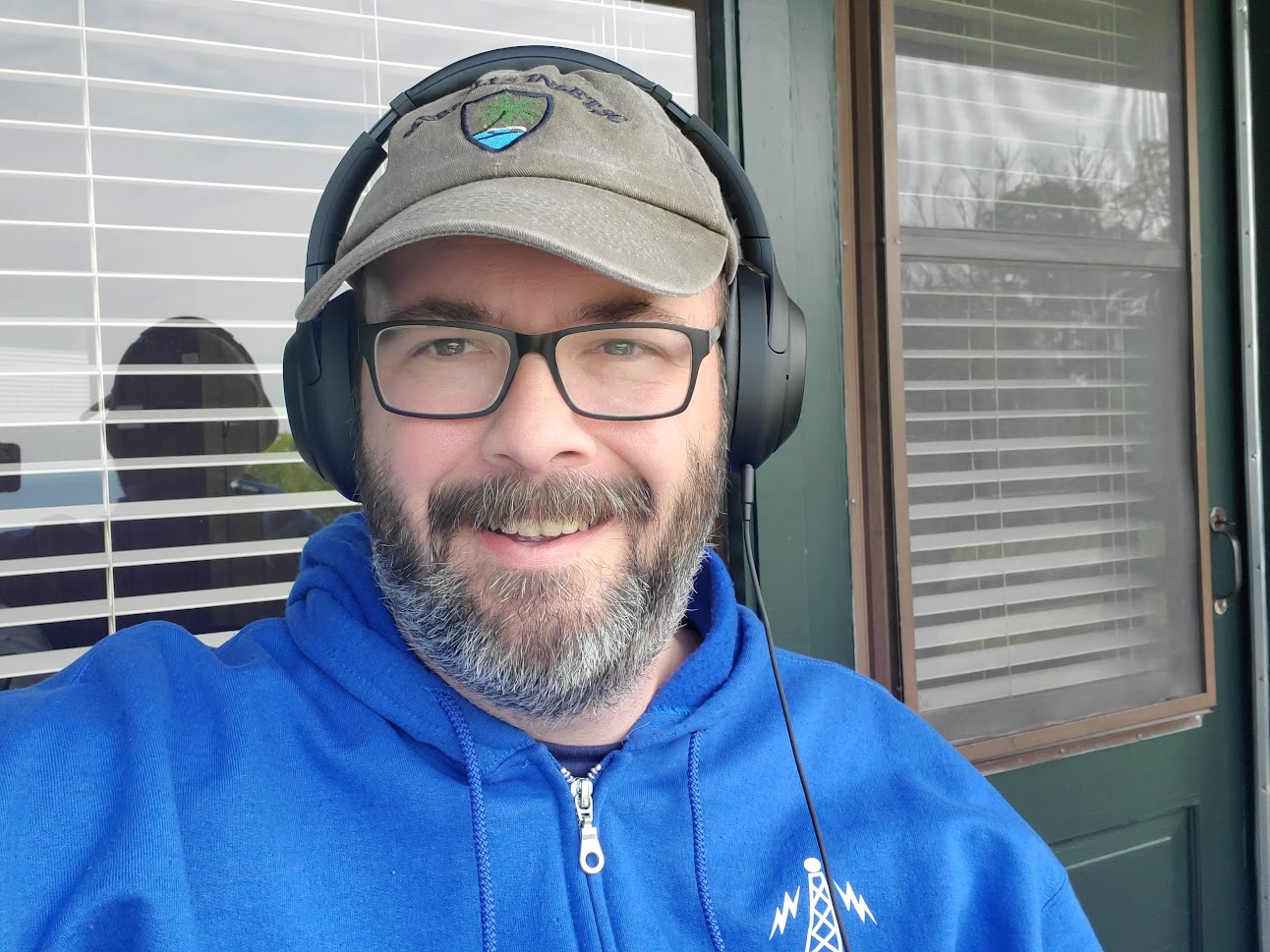
After dinner we made it back down to our hotel for the evening and I got back on the air at 1:19Z on 40m SSB. Almost immediately I got a bunch of hunters responding to my CQ. I got 28 SSB contacts in 27 minutes before deciding to make the switch over to CW. On CW I hunted a Park to Park and then set up shop calling CQ. I ended up making 24 more contacts while calling CQ in 39 minutes and then I called it an activation to get some sleep. In all my second late shift of the trip had 53 contacts (28 SSB and 25 CW) with Massachusetts, New York, New Jersey, Ontario (Canada), Pennsylvania, Ohio, Virginia, Maryland, North Carolina, South Carolina, Georgia, Florida, Alabama, Tennessee, Kentucky, West Virginia, Michigan, Minnesota, Kansas, and Illinois. Not bad for 1:17 on the air!

6/20/2022 Activation QSO Map: Green Pins = CW, Red Pins = SSB / Green Lines = 40m
I had an absolutely wonderful time up in Shenandoah National Park with my family and was very pleased with all three activations and two late shifts during my time on the mountain. In total I was able to make 147 contacts over 3 Zulu days in the park -- 75 CW, 67 SSB, and 5 FT8. Operating from the hotel balcony inside the park was a wonderful treat, and the South River Picnic Grounds had their charms, too. The QSO map for the entire trip is down below.
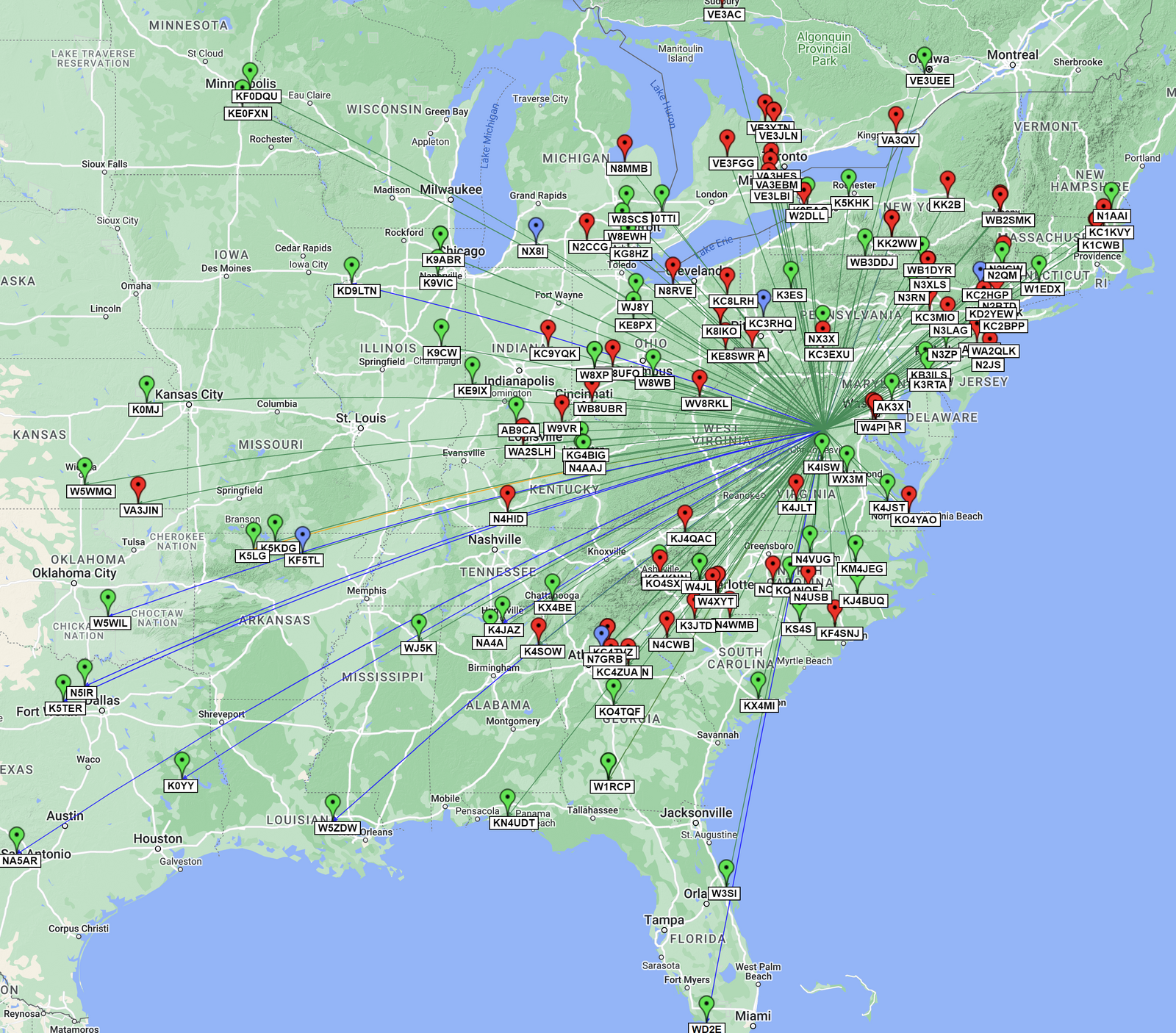
Entire Trip QSO Map (6/18/2022-6/20/2022): Red Pins = SSB, Green Pins = CW, Blue Pins = FT8 / Green Lines = 40m, Orange Lines = 30m, Blue Lines = 20m
Gear used in this activation
- Icom IC-705
- MFJ 1984 MP End-Fed Half Wave Antenna
- LDG Z100 Plus
- CW Morse Pocket Double Paddle Morse Code Key with Magnets
- CW Morse Steel Base for Pocket Paddles
- RigExpert Stick Pro Antenna Analyzer
- Icom LC-192
- Bioenno 12V 6Ah LiFePO4 Battery
- Sony Headphones
- Dell XPS 13 Laptop
- Camp Chef Mesa Folding Aluminum Table
- Rite in the Rain Notebook
- Zebra DelGuard Mechanical Pencil
- Fellow Carter Move Mug (12 oz ... for coffee)
Posted on June 21st, 2022
POTA Activation #13 - Four Parks on CW over Two Days with a Late Shift - George Washington Memorial Parkway, Potomac Heritage NST, Star Spangled Banner NST, and Captain John Smith Chesapeake NHT (VA) (6/16/2022-6/17/2022)

Life has been busy of late and it had been a few weeks since I was able to get out into the field and activate a park. My schedule on the weekends has been completely filled, so when my buddy Gersohn mentioned doing an activation together, I had to get creative. Ever since my Fairy Stone State Park activation, I wanted to get in another Late Shift. I also have been spending some time learning about the park boundaries in my area and exploring the possibilities when it comes to multiple activations. I've gotten more familiar with the National Park Service web site and the mapping features therein. Through that exploration I've come to realize that there are a lot of overlapping and adjacent parks in the DC metropolitan area. Some of these overlaps are difficult to access, but I found a few places that have 4 parks in one location that don't involve climbing through forests of poison ivy.
How is this possible? Well, in addition to the traditional idea we all have of a park with specific boundaries, the NPS also designates several National Historic Trails and National Scenic Trails. Some of these are on land, while others are on the water. Some are on both. The Captain John Smith Chesapeake National Historic Trail is a water-based trail that covers much of the Chesapeake Bay watershed, including much of the Potomac River. Since operating on a trail is generally bad form (you don't want to block a trail with your gear ... and operating on the water can be a challenge) you're allowed to claim a trail as long as you're within 100 feet of it. So for the Captain John Smith Chesapeake NHT, if you're within 100 feet of the Potomac where it goes, you're able to claim it. The Star Spangled Banner National Scenic Trail has portions that are on roads and others that are on waterways. North of Alexandria City it largely follows the George Washington Memorial Parkway and South of Alexandria it follows the Potomac River for a while. Finally, the Potomac Heritage National Scenic Trail has many disjoint sections on the map. There are proper trails, as well as trail spurs that are disconnected.
I found a couple locations where all of these parks coincided within the rules of POTA and got excited for the possibilities. The last thing I had to do was look at operating hours, if I wanted to do a late shift. Many of the parks are closed at dusk, which isn't great for a late shift, even as we approach the longest days of the year. I discovered that the parking lot by the Lyndon Baines Johnson Memorial Grove in DC was open until 10 PM and was walking distance to the spot on the other side of the humpback bridge where the 3 trails and the George Washington Memorial Parkway overlapped.
We had a plan. After work we could get to the spot around 6-6:30, get our activation for day 1, keep operating past 8:00 for day 2 (the next Zulu day) and get a second activation and a late shift. With 4 parks in two "days", that's 8 activations in about 3 hours in the field. Gersohn and I were excited and got our gear together ready to hit the park. Then this happened:

The weather situation was not looking good. That mass of red, orange, and lightning bolts was hurtling toward our operating position right as we were about to depart. We decided to go anyway and make a last minute call when we got to the LBJ Memorial Grove parking lot. If the weather would render our activation unsafe we could go into the marina area and get a bite to eat while we waited out the maelstrom. Thankfully, the weather gods were with us and the bad weather went just South of where we were to operate. No rain, and the lightning was safely to our South. The activation was a go.
Gersohn had a brand new cart to help bring my camp table and some of our bulkier gear. Being at a 4 park nexus meant we had no picnic tables at our disposal. We had to pack it all in and then pack it all out. Once we found a flat spot within 100 feet of the water and 100 feet of the roadway we set up our table and radios and then got our antennas in the air. I used my arborist throw-line and Gersohn use an air cannon he had built specifically for the purpose. Traffic had pushed us closer to the end of the Zulu day than I had hoped, so I got my station up as quickly as I could, plugged in my CW paddles, tuned to 7.050 MHz and started calling CQ POTA.
I didn't have to wait long. One after another they came, sometimes piling up. I didn't really get any breaks for about an hour and a half, and even then it was only long enough to take a sip of my water and catch my breath. So much fun. My calls were answered from New Jersey, Virginia, North Carolina, Georgia, Maryland, Ohio, New Hampshire, Delaware, Kentucky, Florida, Pennsylvania, Indiana, New York, Illinois, Oklahoma, Ontario (Canada), Kansas, South Carolina, Missouri, Tennessee, Michigan, Wisconsin, North Carolina, Minnesota, Texas, and Puerto Rico. In all, 68 contacts, a new record for me (although, it was technically split over two activations ...). The signal reports I was getting were fantastic, mostly 559-599 with a few fringe reports coming in as well. It never ceases to amaze me what's possible with 10 Watts and a bit of wire. Although the prior activation saw my first time having enough CW contacts to make a valid activation, it was mixed-mode. This activation was entirely in CW. My goal of having a complete activation with nothing but CW was met and then some. I really felt myself get into a groove with it and it was a lot of fun. Multiplying the 68 contacts over 4 parks gave 272 contacts! I was so busy I never had a break to change bands. While I had to throw in a few question marks here and there, everything went smoothly and I think I can safely say I'm a CW operator now.
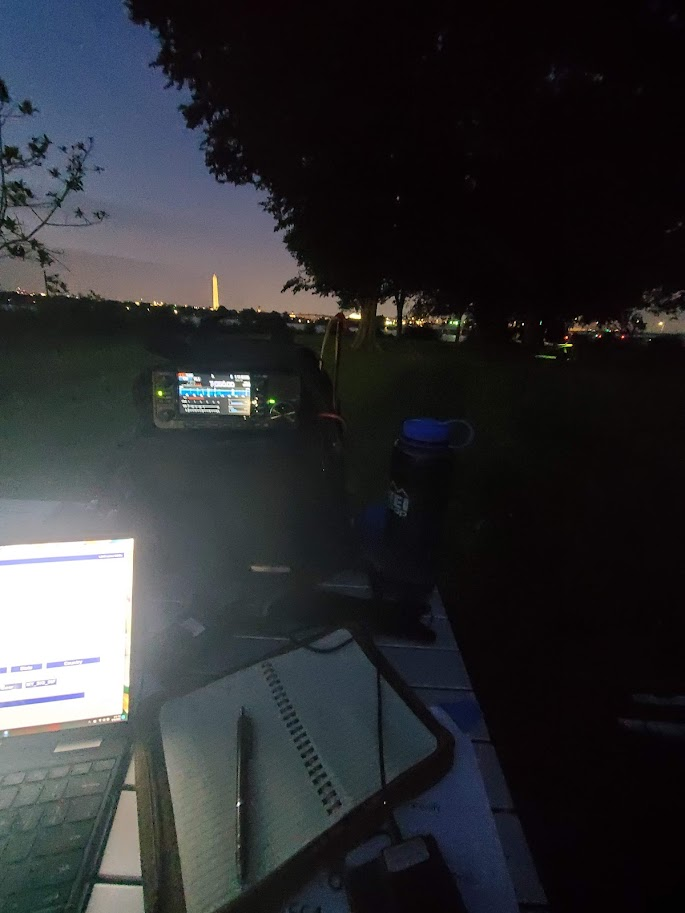
The location was not one to disappoint either. It was just North of the Mount Vernon Trail spur to the 14th Street Bridge into Washington, DC. I had biked by it hundreds of times, but had never pulled off into the grass at the spot before. The view from our table was a stunning panorama of DC's monumental core. Right in the middle was the George Washington Memorial standing 555 feet 5.5 inches tall surrounded by the Jefferson, Lincoln, and FDR Memorials. We could see the Kennedy Center off to the North and the lights of the city shimmering on the Potomac. All the while we could watch the traffic on the 14th Street Bridge. As the day became night we were also treated to a dazzling light show as hundreds of fireflies lit up the small grove of trees ahead of us on this beautiful point into the Potomac. As I got more comfortable in my copy of the code I leaned back to soak it all in and watch the beauty happening right in front of me. Although I had seen this spot hundreds of times on bike commutes, it took an activation for me to truly experience it. Simply stunning.
A little bit after 9 PM, both activations made, I turned off my rig and started to pack up my gear under the light of my headlamp. I've been getting into a good rhythm putting up and taking down my gear. The replacement insulator I designed and 3D printed in PETG for my MFJ 1984 MP (the supplied one broke) did a great job and was very easy to deploy. I even embossed my call in it for fun. After getting everything into our bags and loading up Gersohn's cart, we wheeled everything back to my car and were able to head out right around the closing time of Columbia Island. Another 8 activations in the book from POTA's perspective, and a whole lot of fun. Since we were in a bit of a hurry to get there, we decided to head over to Bob and Edith's diner over in Huntington for a late dinner. We had a great meal and even better conversation before calling it a night. The QSO map below shows just how well CW can do on 10 W ... pins everywhere! Such a great time.
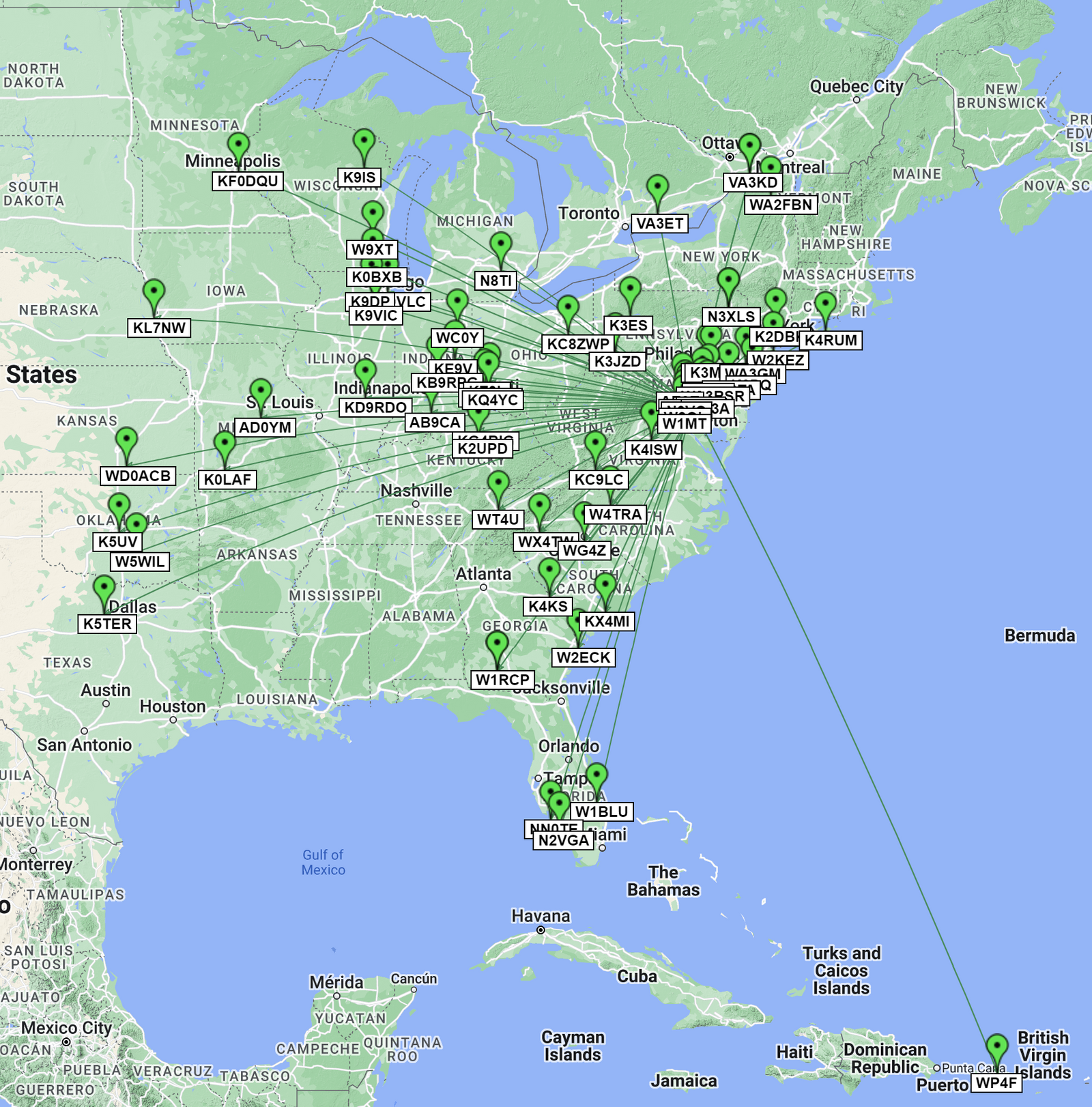
Gear used in this activation
- Icom IC-705
- MFJ 1984 MP End-Fed Half Wave Antenna
- LDG Z100 Plus
- CW Morse Pocket Double Paddle Morse Code Key with Magnets
- CW Morse Steel Base for Pocket Paddles
- RigExpert Stick Pro Antenna Analyzer
- Icom LC-192
- Zebralight H600Fc Mk IV Headlamp
- Bioenno 12V 6Ah LiFePO4 Battery
- Sony Headphones
- Dell XPS 13 Laptop
- Camp Chef Mesa Folding Aluminum Table
- Rite in the Rain Notebook
- Zebra DelGuard Mechanical Pencil
Posted on June 17th, 2022
HamGadgets Ultra PicoKeyer Kit Build and Review
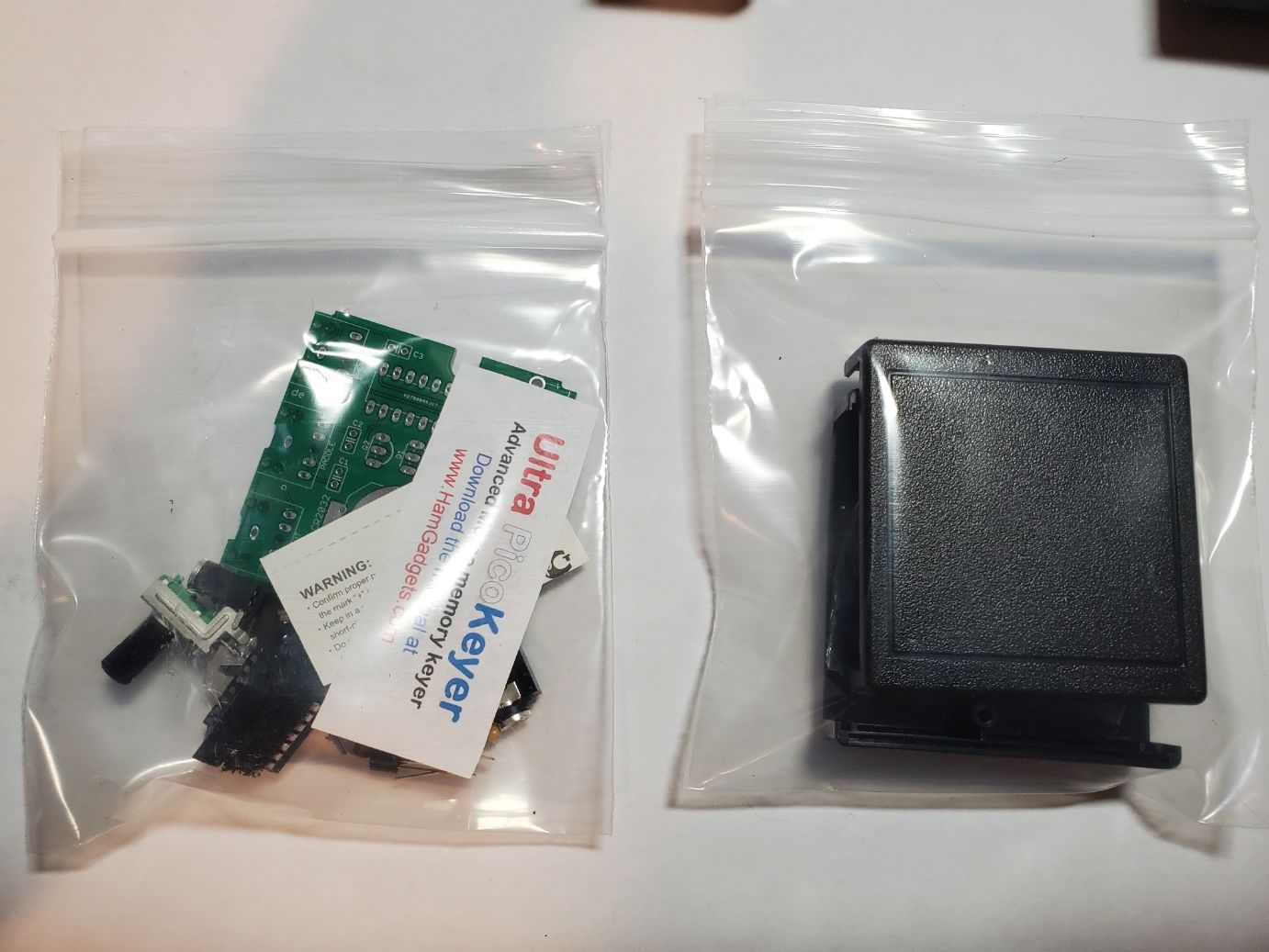
One of my goals for this year was to become a more capable CW operator and be able to have a valid POTA activation using nothing but Morse code. While I haven't activated solely with Morse code as of this writing, I did get 11 contacts during my activation at Theodore Roosevelt Island on 5/28/2022, which would be a valid activation if taken by itself. I was able to hit this milestone well before I thought I would be able to, which surprised me. What surprised me even more is how much I enjoy working CW. While I have a straight key, I've found that I enjoy using an iambic key for operating as it does a great job at keeping the code I'm sending consistent and on-speed. For portable operation, my Icom IC-705 has a built-in keyer that does a great job, but for my older Kenwood TS-440S that I use at home, I need to use an electronic keyer in tandem with the key to get my code on-the-air.
To that end, I had been using the Morserino kit that I reviewed earlier. It does a great job as a keyer (as well as being great for code practice and echo training, along with many other features), but it has one feature that makes it difficult to use as a dedicated keyer. After a period of inactivity it shuts itself off to preserve battery life, even if it is plugged-in. After having it shut-off in the middle of a couple MVARC CW Roundtables right before my turn to send, I decided I needed a dedicated electronic keyer. Thankfully, Thomas (K4SWL) had a write-up of an activation at QRPer.com where he was using a Yaesu FT-817ND without a built-in keyer and was using the HamGadgets Ultra PicoKeyer. It looked like a great solution, so I went on over to eBay to order one for $44.95 plus tax and $5.95 in shipping. Since my purchase the price appears to have gone up about $5.
I ordered on June 9 and it was at my door June 13 via the US Postal Service. It was well packed inside a cardboard box filled with two poly bags containing the parts and a case. Some newspaper served as padding inside the box and everything arrived as expected. I went to the HamGadgets site to download the instruction manual, did a quick inventory of the parts, turned on my soldering iron, and got down to business.

The build itself was very straightforward and consists entirely of through-hole components. I was able to finish the entire build in about an hour of relaxed assembly. The instructions were clear and easy to follow. The only hiccup was that the instructions mentioned a few capacitors that were supposed to be on a paper holder that were loose within the poly bag. There are a couple different types of capacitors in the kit, so I needed to inspect the labels on them to ensure I was installing the right ones. Thankfully, the needed information was on the instructions, and after a little squinting, I was able to identify which ones went in what places. In all there is a coin cell battery holder, 3 x 3.5mm (1/8th inch) stereo jacks, 4 momentary push-button switches, a potentiometer, 2 transistors, 3 capacitors, a small speaker, and a microcontroller chip with a DIP socket to install. There are multiple capacitors provided so you can tailor the sound level of the headphone output, depending on the impedance of the headphones you would like to use. When you're done with the circuit board build the moment of truth comes when you insert the CR-2032 coin cell battery (provided). If everything is wired up properly, the on-board speaker sends "73" on power-on. Happily, I was greeted with a cheerful "73" and everything worked the first time.

With the circuit assembled, it was time to put it into its case. When you buy the kit from eBay, they mention that there are 6 colors available for the front and back panels (black, white, blue, gray, green, and red). There isn't a check-box, so make sure you put in as a message to the seller on check-out or you'll get the default color of black. I requested the red panels and they fit the case snugly. They look to be 3D printed with recessed labels for the buttons and jacks. The case itself appears to be injection molded plastic and is held together with a couple screws that are provided. Once it is together it makes for a handsome little box that is quite small (a photo below shows a quarter for scale alongside my CWMorse Pocket Paddle).
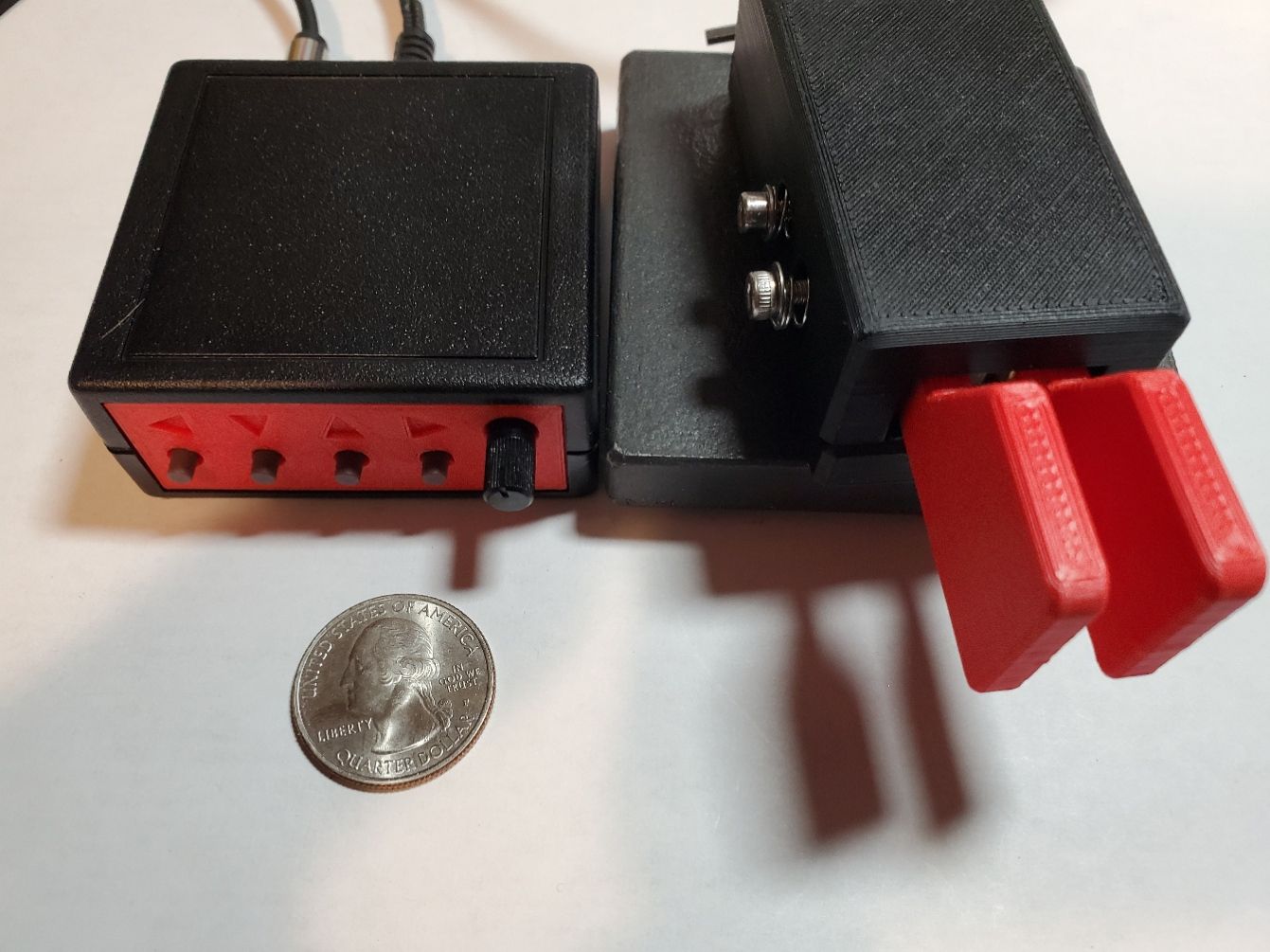
Once it is all together, the unit is ready to be connected to your paddles via a 3.5 mm stereo cable (not provided). 3.5mm jacks are also provided for a pair of headphones (without volume control -- that's why the capacitor selection is important) and to control the key input on your rig. By itself, it works as a practice oscillator, and teamed with your radio you're ready to transmit. Out of the box the key speed is set to 13 words per minute if the potentiometer is fully counter counter-clockwise. Otherwise, the potentiometer allows you to change your speed between two values that you can set -- by default the range is 5-30 WPM, but 5-60 WPM is supported. The full left rotation setting is also able to be set, so you can set a favorite speed for the far left rotation, then QRS or QRQ as needed. Although the potentiometer is analog, the actual setting is digital. If you would like to know what speed you are sending pressing the buttons for ▼ and ► together (the second and fourth buttons) will send the current speed in Morse code over the internal speaker.
Pressed by themselves, the four buttons act as memory keyers. They are easily set by pressing the button until a "K" is sent through the speaker. Then key the message desired into memory, press and hold the same button, and when you hear an "R" you're done. To abort, press any other key instead. Short pressing the key will now send your message at the current speed. This is very helpful for sending a CQ message repeatedly, as well as for sending your call, or a contest exchange. There is even an option to use a QSO counter for contests that have a serial number in the exchange that gets incremented during each QSO. The memories even have their own scripting language of sorts to allow for words to be repeated, pauses to be inserted, QSO numbers to be incremented, speed to be changed, and for things like QRSS to be done. The repeats can be especially helpful as the memories themselves are limited in length, so using the scripting commands (using the / character) allows you to get more out of the memories. Each of the 8 main memories can contain 127 characters. They can also be chained together using the commands. There are 4 messages readily accessible, and in the settings menu you can move to a second bank if desired, but this is not something you'd be able to do quickly during a QSO.
There is also an extensive setup menu (entered using the ▲ and ► key combination -- buttons 3 and 4) that uses Morse code to communicate with you to announce the feature, its current value, and then allow you to modify it using the buttons. I found most of the defaults to be satisfactory, but you can modify the stored speed for the fixed speed, the QSO number, set the range for speeds on the potentiometer, enable or disable automatic letter spacing, enable or disable leading zeroes for the QSO numbers, set a beacon delay, change the weight for the code being sent, enable or disable the sidetone, choose your keying mode (iambic A, iambic B, and Ultimatic are supported as well as a straight key mode and a bug mode that simulates a bug style key), choose which side on your paddle is a dit, what frequency the sidetone is sent at, which bank to use for memories, and whether to have the menu send long titles for each menu item.
It is quite full featured for something that is so small. HamGadgets says that in normal usage the battery that is supplied should last about a year. Within a few seconds of inactivity the microcontroller for the unit goes to sleep to save power, but hitting a button immediately wakes the unit and performs the requested operation. For the end user, the effect is that the unit is always "on" and ready for use while being power efficient.
It is not without its faults, although the ones I have found are fairly minor. The speaker on the unit is not very loud, especially inside of the provided enclosure. If your primary use is for a code practice oscillator for use without headphones, this may be a problem. I use it as a keyer for my rig, so that isn't an issue for me, but it is worth noting. The lack of a volume control for headphones may similarly be an issue. The volume is adjustable by changing the soldered capacitor depending on the impedance of the headphones, but it is not able to be changed in normal use. A passive headphone volume control could be added if attenuation is needed. Some users may be unhappy with the default sidetone frequency of 2,000 Hz (700 Hz is the standard for most similar devices). The sidetone can be changed in a menu setting, but the manual suggests keeping it at 2,000 Hz as that is where the supplied speaker has peak loudness. Considering how quiet it is at 2,000 Hz in the case, I've elected to keep it where it is, although I do wish it was closer to 700 Hz. That said, when operating my rig, I hear its sidetone through my headphones, so the speaker isn't necessary for on-the-air usage. The menus are fairly involved, and to use them successfully you must know Morse code as there is no display. That said, the documentation is thorough and easy to follow and if you're buying a CW keyer, you probably already know or are in the process of learning Morse code, so that's not likely to be an issue for long. Finally, although long-lived, the reliance on a coin cell battery inside of a case with a screw enclosure means that if the battery dies while away from the shack, it isn't easy to change in the field.
I've been very pleased with the HamGadgets Ultra PicoKeyer. As a kit, I would say that the Ultra PicoKeyer would be suitable for beginners. If you can make a basic solder joint, this kit is easy to build and hard to mess up. As a keyer, it does a great job in a compact and inexpensive package that is power efficient and easily portable. The memory keying features make it a great companion on-the-air, whether calling CQ, activating a park on POTA, or working a contest. It was fun and quick to build and works well.
Posted on June 14th, 2022
POTA Activation #12 - Theodore Roosevelt Island (DC) (5/28/2022)

Getting out into the field to activate a new park is always a lot of fun. Getting to do it with a friend is even better. Gershon, KO4IUK, let me know that he had some time available on May 28, 2022, the Saturday of Memorial Day weekend. Conveniently, I was able to get out for a few hours so we decided to activate a new (to us) park -- Theodore Roosevelt Island in Washington, DC.
I have visited this park on multiple occasions. It is a often overlooked gem right in-between Georgetown and Rossyln on an island in the Potomac River. It can be accessed by bike, on foot, or on the Northbound side of the George Washington Memorial Parkway. Parking is limited, so you may have to wait for a spot to free up when there are a lot of visitors and you're visiting by car. The island is a memorial to President Theodore Roosevelt, who was instrumental in the creation of the National Park Service. The island itself is closed to vehicles and is accessed through a footbridge that crosses from Virginia over a part of the Potomac River to the island in the District of Columbia.
Once on the island there are several trails traversing the island. Some skirt the coast and offer beautiful views of the Potomac and the marshland on the island. Others climb up into the interior. A short distance from the footbridge is a striking memorial to Theodore Roosevelt with a statue that towers over an expansive plaza. Initially we tried to get an operating location near the coast since if we were to operate within 100 feet of the Potomac River, it would have been a twofer with Captain John Smith Chesapeake National Historic Trail. Unfortunately, muddy conditions and dense vegetation made that more difficult than it was worth, so we decided to set up camp on the outskirts of the memorial itself, well away from the heavily trafficked areas so as not to interfere with the enjoyment of the visitors to the memorial.
Gersohn and I had a lot of gear we brought-in together. I had my radio in my backpack, but also took my Camp Chef Mesa table and a Wren folding chair which ended up holding the matching unit for my antenna as we sat on the ledge to the memorial. I also opted for my laptop so that I could introduce Gersohn to operating with FT8. I brought the Buddistick Pro as well as my MFJ 1982 MP End Fed Half Wave antenna. I decided to use the EFHW for this activation for its frequency agility and since I was near some great trees. Gersohn brought his more high-powered setup along with his Alpha Antenna vertical and we got setup pretty quickly.
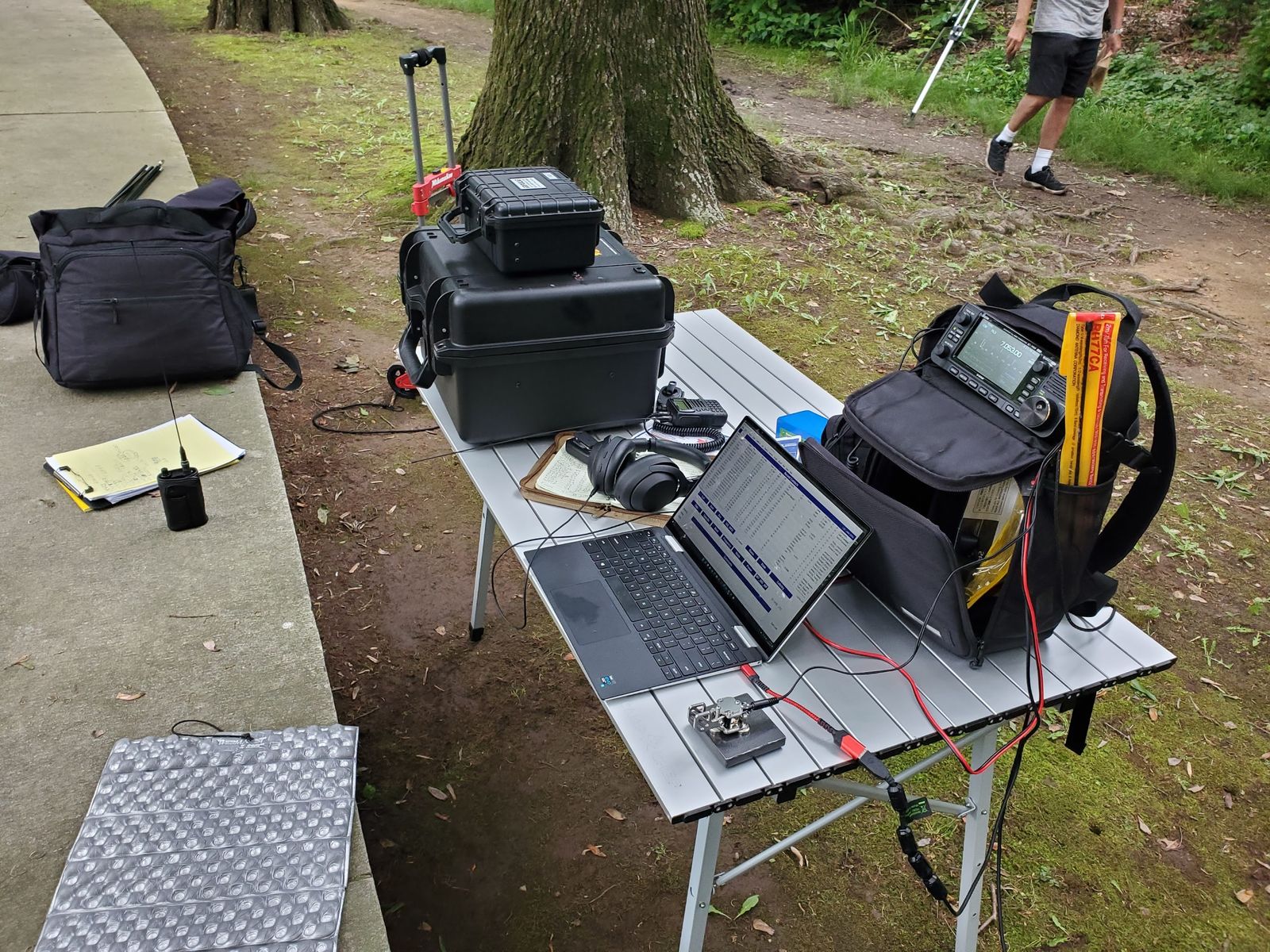
Some activations can be a real challenge on 10 W, while others just seem to come easy. This one was the latter. I set myself up on 40 m SSB, self-spotted, and I was off. My first contact was with New Jersey followed by New York, Ohio, Pennsylvania, Ontario (Canada), Connecticut, North Carolina, Tennessee, Virginia, Vest Virginia, and Massachusetts. In all, I had 21 contacts on SSB, including 3 Park to Park contacts with Ontario (Canada), Pennsylvania, and Virginia. Next I moved over to 2m and 70cm to make some calls on the calling frequencies. Unfortunately, nobody outside the park answered, but Gersohn and I made two inside-the-park Park to Park contacts for fun. Next I hopped over to 20m to do a little FT8 on the laptop and show Gersohn how it works. I made 3 Park to Park contacts with the Dominican Republic, Florida, and Ohio and also contacted Minnesota and Florida (not a park) as well.
Finally, as we were starting to wind things down I mentioned to Gersohn that I had brought my paddles for CW. I have been hunting POTA for a while from home using CW as I've been re-learning Morse code and have been having a lot of fun doing it. I looked on the spots and saw that there was one station in the entire world who activating CW at that time that I could hear, so I decided to throw my call sign out there to see if he could hear me. Turns out, he could, and pretty well at that as I got a 569 report. Unfortunately, nobody else was activating in CW, so I had nobody else to contact. Gersohn suggested I call CQ, and I explained that calling CQ was harder since instead of having all the time in the world to get the call (or get it from the spots) and only having to send and receive a signal report and location you have to decipher the calls in real-time and deal with pile-ups. But as I sat there, I realized he was right. Why not give it a go? So I found a free bit of spectrum at 7.047 MHz and started calling CQ. I had the spots up on my phone and after my first call I saw that immediately my spot updated from the Reverse Beacon Network (how cool is that?) and now I was the second person in the world activating POTA on CW.
A quick aside -- for the last few months I've been practicing my Morse code pretty much every single day. What motivated me to give it another go after learning it 32 years ago to pass my novice exam and then promptly not using it again was POTA. I set a goal for myself -- and when I set it, I wasn't sure it was one I'd be able to meet. I wanted to be able to do a complete POTA activation with CW. After getting started in POTA I found the YouTube Channel of K4SWL as well as his site QRPer.com. Thomas makes what he calls "real-time, real-life activation videos" where he shows an unedited and unvarnished look into his activations for Parks on the Air and Summits on the Air. Most of his activations are on CW (although he does SSB as well), done at QRP power levels, and I quickly got hooked on his videos. You are listening along with him to the calls coming in and can view his log book. I would listen to the code coming in and try to decipher the calls before he wrote them down (and then check my copy). Over time I came to become more comfortable with the cadence of the exchange and was able to understand more and more of what I heard. His activations are usually around 18 words per minute, but he would slow down if someone called slower. He really showed what it was to be a courteous and kind operator and watching his videos was an inspiration. My family may think I'm a bit crazy watching YouTube videos with a bunch of beeping and a steady camera angle of a radio and a notepad, but I could not get enough of it, and went deep into his back catalog and was excited for each new video. His site QRPer.com (and also the SWLing Post) is also great for his activation reports (which inspired me to do something similar here) and honest gear review for QRP rigs and equipment. Seriously, it is great stuff.
So back to the activation. Almost immediately I got a response from W8ARC in West Virginia who heard me at 579. Then came calls from Ohio, New York, Michigan, Georgia, North Carolina, Quebec (Canada), and Pennsylvania. My 10 W on the IC-705 was getting great signal reports -- the lowest was a 559 and I was getting plenty of 599s as well. In the middle of my run had a bit of a pile-up where I could hear that characteristic warble of multiple CW calls overlapping. I took a deep breath and kept my cool, extracting a character or two from the sea of tones and sending it back with a question mark. I had to have a few of the calls re-sent in that manner, and although that was my fear going in (that I'd have difficulty copying) I quickly realized it wasn't a big deal. In fact, after getting a re-send on the calls I got partials on, I got a solid copy on the second go-around and nobody had to correct my copy. Everybody was having a good time. It required my full concentration, but I was doing it. Before I knew it I looked at my log and realized I had just gotten 10 contacts from my CQ calls. A valid activation. I sent out a QRT de N2EC, took a deep breath grew a big grin -- I did it. Technically, the goal was a CW activation, and I had already made the activation on SSB, but if I removed all those other contacts, it would have still been a valid activation. I'll take it.
It isn't everyday that you get to reach a long-term goal you set for yourself. To be honest, I thought it would be a few more months before I gave it a try out in the field. Thanks to Gersohn for pushing me out of my comfort zone and for Thomas for showing me how it could be done. It was an absolute blast. With the adrenaline still running through my veins I took down my antenna, packed up my gear, and headed back to the car with Gersohn, floating on air. So much fun.
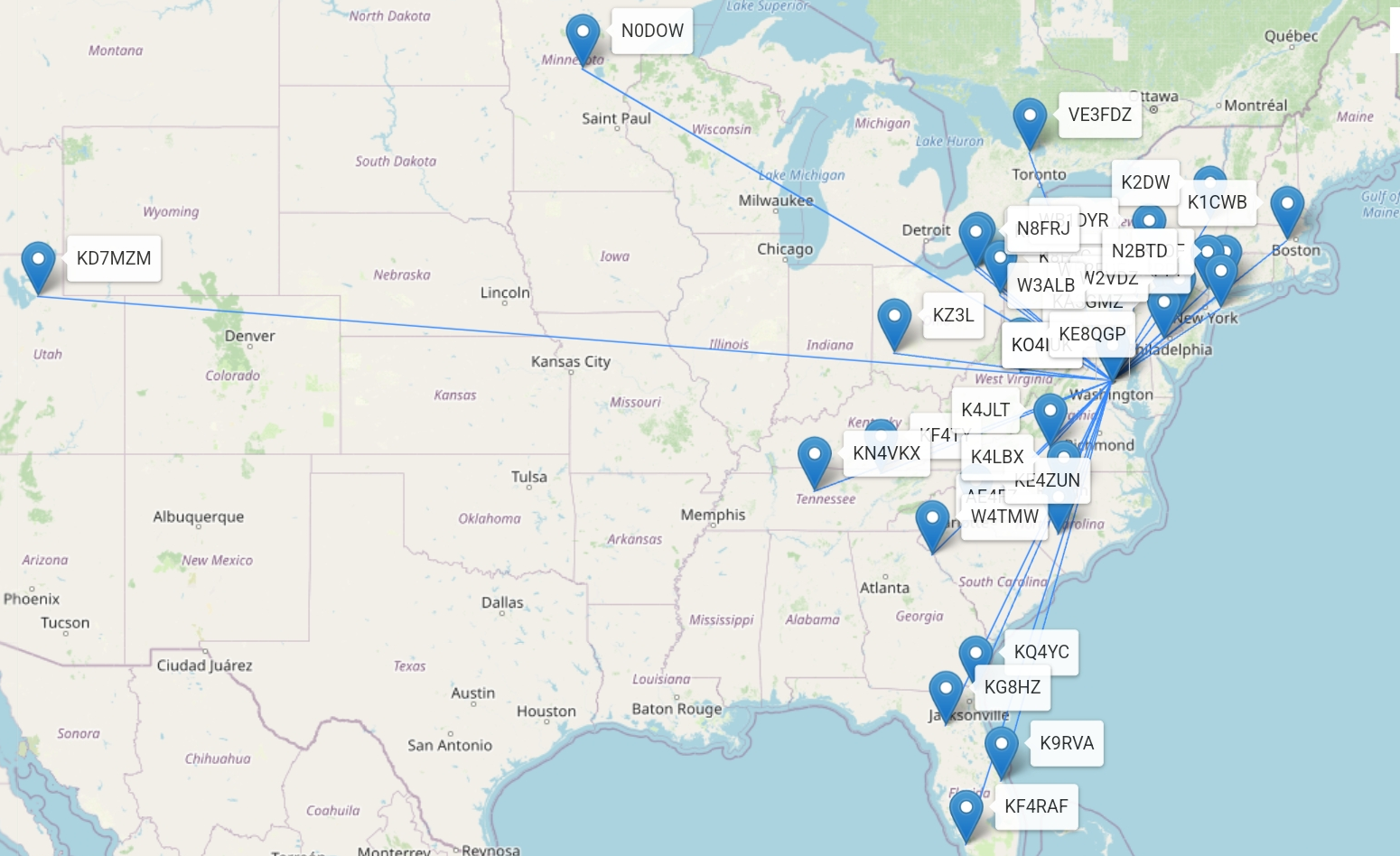
Gear used in this activation
- Icom IC-705
- MFJ 1984 MP End-Fed Half Wave Antenna
- LDG Z100 Plus
- Stainless Steel Double Paddle Morse Code Key with Magnet Base
- CW Morse Steel Base for Pocket Paddles
- RigExpert Stick Pro Antenna Analyzer
- Icom LC-192
- Bioenno 12V 6Ah LiFePO4 Battery
- Sony Headphones
- Dell XPS 13 Laptop
- Camp Chef Mesa Folding Aluminum Table
- Rite in the Rain Notebook
- Zebra DelGuard Mechanical Pencil
Posted on May 31st, 2022
POTA Activation #11 - Fairy Stone State Park (VA) (5/14/2022)
Over the weekend of May 14, 2022 my daughter's Girl Scout troop had a cabin camp scheduled at Fairy Stone State Park in Southern Virginia. I am the camp and cookout certified parent in the troop, so I was excited to be able to join them on the trip. Our family had visited Fairy Stone a few years ago and had a great time in our cabin enjoying some time away from it all and hiking on the trails that the park has to offer. For this outing, I decided to bring my portable radio setup and see if I could manage an activation while staying in the park.
The park is somewhat remote with spotty cellular service, so I made sure to schedule my activation window on the POTA web site so if I did FT8 or CW I would show up on the spotting section of the site. We made the five hour drive down to the park after the girls were done with school for the day and got settled in the lodge that we rented for the troop. The lodge was spacious and quite nice with a well equipped kitchen, a gas fireplace, and a dining room table that was able to accommodate the entire troop.
After getting situated I decided to setup under awning that went over the sitting area by the front door to keep out of the light rain that was a persistent companion. I was able to use my new aluminum Camp Chef Mesa folding table to set up my equipment and used one of the rocking chairs out front as my seat. Since it was dark, I figured it would be easiest to get on the air with my Buddistick Pro antenna, so I set it up in the clear and started trying to make some calls for my first attempt at a late shift activation. SSB was fruitless, but I decided to take my first attempt at using FT8 to make my activation. For those who may not know, POTA uses Universal Coordinated Time to determine the boundaries of a day. So even though I started on Friday night, any time after 8 PM Eastern is actually the following day in UTC. Also, any activation that happens between 0000-1200Z (8PM-8AM Eastern) is considered a "Late Shift" and is counted as that on the site.
I had to dial back the power initially as I was having some issues with RFI causing my sound card connection to fail on the IC-705, but once I got down to around 5 W, I was able to have a reasonably reliable connection. Later on I was able to shift some of the gear to reduce interference. I was able to get out on 40 m pretty well, making my first contact with Iowa. Next came New York, Tennessee, Texas, Illinois, Michigan, Wisconsin, California, Idaho, Colorado, Missouri, Florida, and Oklahoma. It wasn't the fastest activation, and I have to admit I missed the conversational nature of SSB, but I had successfully activated for the Zulu day, so the pressure was off to make my 10 on the local Saturday.
The girls had a bunch of activities planned, including working on the ARRL Radio and Wireless Technology badge program. When they had a break in their activities, they came out to see the radio setup. We talked about how the station worked and I told them about the contacts I had made at night. There was a lot of interest in Morse code, so I showed them my portable paddle and let them send some code using the 705 as an oscillator. They seemed to get a kick out of me sending their names in code to them. Next we tried to make some contacts, but it was in the morning and the bands were pretty dead. I decided to get my EFHW into a nearby tree to see if a change of antenna would do the trick, but we had nothing but crickets on SSB. Unwilling to give up, I hooked up the computer and got on FT8, this time on 20m.
Immediately we were able to make contacts, which I was able to show them on GridTracker so they could see how far we were going on our low power. Digital was able to save the day again. We contacted stations in Minnesota, Texas, Washington, and Florida and decided to call it a day on the bands. Since our activation had already been made for the Zulu day, we were happy for the contacts we made.
The rest of the trip we got to enjoy some truly wonderful ranger programs where we all learned a lot about the park and its inhabitants. We also got to go hunting for Fairy Stones, which are found in some dry stream beds on the outskirts of the park that have crystal formations that are distinctive. The girls loved getting their hands dirty and the park allows visitors to take the fairy stones they find home. I had a lot of fun scrambling over the hillside with them to hunt for the stones.
All in all it was a great weekend. We had a lot of fun at Fairy Stone State Park and I'm glad we got to get an activation in and work toward their Radio and Wireless Technology Patch. Maybe some of the scouts will be interested in pursuing their license someday. Unfortunately, I forgot to take pictures of the activation, but I did make a map of the QSOs below.

Gear used in this activation
- Icom IC-705
- Buddipole Buddistick Pro Antenna
- MFJ 1984 MP End-Fed Half Wave Antenna
- LDG Z100 Plus
- RigExpert Stick Pro Antenna Analyzer
- Icom LC-192
- Bioenno 12V 6Ah LiFePO4 Battery
- Sony Headphones
- Dell XPS 13 Laptop
- Camp Chef Mesa Folding Aluminum Table
- Rite in the Rain Notebook
- Zebra DelGuard Mechanical Pencil
Posted on May 19th, 2022

